#Timber Windows Devon
Explore tagged Tumblr posts
Text
Timber Windows in Devon: Bespoke Windows for Commercial Properties
Elevate your commercial property with bespoke timber windows in Devon, delivered by ADS Commercial. We offer the finest quality timber windows in Devon. Our Devon timber windows come with excellent insulation, security, and aesthetics. Get a free quote!
0 notes
Text
Heritage Windows in Honiton & Devon – Timeless Elegance with Modern Performance
Bring classic charm and modern efficiency to your property with our stunning heritage windows in Honiton & Devon. Perfect for period homes or anyone seeking traditional aesthetics, these windows combine timeless design with cutting-edge technology.
🌟 Why Choose Heritage Windows?
Authentic Design: Replicate the appearance of traditional timber windows with slim frames and authentic detailing.
Energy Efficient: Advanced glazing and insulated frames keep your home warm and reduce energy costs.
Low Maintenance: Unlike timber, heritage windows resist warping, rotting, and peeling, requiring minimal upkeep.
Customizable Styles: Choose from a variety of finishes and configurations to match your property’s character.
Enhanced Security: Built with robust materials and modern locking systems for complete peace of mind.
Whether you’re restoring a period property or enhancing a modern home, our heritage windows offer the perfect blend of elegance and functionality. Contact us today to learn more about our options in Honiton & Devon!
0 notes
Text

“Ash (Fraxinus excelsior).
In the nineteenth century it was believed that if ash trees failed to produce fruit — keys — disaster was foretold.
In Yorkshire:
Some people every summer examined the ash tree . . . to see whether or not they had produced any seed; for the barrenness of the ash was said to be a sure sign of public calamity. It was a tradition among aged and thoughtful men, that the ash trees of England produced no seed during the year in which Charles the First was beheaded. [Jackson, 1873: 14]
In East Anglia:
The failure of the Crop of Ash-keys portends a death in the Royal Family . . . The failure in question is certainly, in some seasons, very remarkable; many an old woman believes that, if she were the fortunate finder of a bunch, and could get introduced to the king, he would give her a great deal of money for it. [Forby, 1830: 406]
ROWAN Or mountain ash, an unrelated tree which has leaves similar to those of ash, was widely considered to provide protection. Occasionally ash itself was also believed to be protective.
Rowan and ash sticks were used to drive cattle . . . believed to be 'kindly' and both trees were believed to be endowed with properties that ensured no interference from harmful influences. [Larne, Co. Antrim, October 1993]
In rural areas 'even' ash leaves-those leaves which lack a terminal leaflet and therefore have an even number of leaflets-were used in love DIVINATION. In Dorset:
The ash leaf is frequently invoked by young girls as a matrimonial oracle in the following way: The girl who wishes to divine who her future lover or husband is to be plucks an even ash leaf, and holding it in her hand, says:
“The even ash leaf in my hand, The first I meet shall be my man.’
Then putting it into her glove, adds:
‘The even ash leaf in my glove, The first I meet shall be my love.'
And lastly, into her bosom, saying:
‘The even ash leaf in my bosom, The first I meet shall be my husband.'
Soon after which the future lover or husband will be sure to make his appearance. [Udal, 1922: 254]
According to a 52-year-old woman who described how she used ash leaves for divination during her childhood:
Start at the bottom leaflet on the left-hand side and say:
“An even ash is in my hand
The first I meet will be my man.
If he don't speak and I don't speak,
This even ash I will not keep.”
As each word is said, count a leaflet around the leaf until the rhyme is completed (this probably entails going round the leaf several times). When the rhyme is finished, continue by reciting the alphabet until the bottom right-hand leaflet is reached. The letter given to this leaflet gives the initial of your boyfriend. Two or three leaves may be used so that you get a greater range of letters. [Thorncombe, Dorset, June 1976]
In many parts of northern Britain ash was known as esh. In north Lincolnshire:
There is a widespread opinion that if a man takes a newly-cut 'esh-plant' not thicker than his thumb, he may lawfully beat his wife with it. [Britten and Holland, 1886: 170]
Burning the ashen faggot — a faggot made from young ash saplings — was a widespread Christmastide custom in Devon and Somerset during the nineteenth and early twentieth centuries. According to a late nineteenth-century writer, it was:
an ancient ceremony transmitted to us from the Scandinavians who at their feast of Juul were accustomed to kindle huge bonfires in honour of Thor. The faggot is composed of ashen sticks, hooped round with bands of the same tree, nine in number. When placed on the fire, fun and jollity commence-master and servant are now all at equal footing. Sports begin-jumping in sacks, diving in the water for APPLES, and many other innocent games engage the attention of the rustics. Every time the bands crack by reason of the heat of the fire, all present are supposed to drink liberally of cider or egg-hot, a mixture of cider, eggs, etc. The reason why ash is selected in preference to any other timber is that tradition assigns it as the wood with which Our Lady kindled a fire in order to wash her new-born Son. [Poole, 1877: 6]
Ashen faggots are still burnt in a few West Country pubs, and miniature faggots are occasionally prepared for burning on domestic hearths.
On the evening of January sth ('old' Christmas Eve) at Curry Rivel, a Somerset village situated on the southern edge of Kings Sedgemoor, the wassailers go visiting' around the parish with their wassail song and the ashen faggot is ceremoniously burned at the King William IV public house. The faggot is made from young ash saplings and bound with bonds ('fonds,' 'fronds,' 'thongs,' or 'bonds') of withies (osiers); bramble has been used occasionally in the past. The number of bonds is variable but since the bursting of any one during the burning is a signal to ʻdrink up,' decency and country logic demands a 'reasonable few'. Either five or six are normally used. At the appropriate moment the faggot is placed on the fire, traditionally by the oldest customer-one villager can recall the fag- got being brought in a wheelbarrow as was 'right and proper'-and as each bond bursts there is much cheering and a general clamour for drink. The landlord, Mr John Cousins, prepares a bowl of hot punch for the occasion to augment the barrel of beer usually provided by the house Brewery. Until quite recently cider was consumed in large quantities; the 'brew' of cider and perry donated by the (Langs) Hambridge Brewery in 1957 is particularly remembered. [Willey, 1983: 40]
In the first half of the nineteenth century:
Some towns in Somerset held 'Ashen Faggot Balls'. The one in Taunton on January 2nd, 1826 was 'most respectably attended by the principal families of the town and neighbourhood'. It was still held twenty years later, but by then the event was losing its appeal. [Legg, 1986: 54]
In some parts of southern England ash twigs were carried by children on ASH WEDNESDAY.
In villages around Alton in Hampshire, and as far away as East Meon, near Petersfield, at Crowborough in Sussex, and doubtless in other places, children pick a black-budded twig of ash and put it in their pocket on this day. A child who does not remember to bring a piece of ash to school on Ash Wednesday can expect to have his feet trodden on by every child who possesses a twig, unless, that is, he or she is lucky enough to escape until midday. [Opie, 1959: 240]
I was born and lived as a child in Crowborough . . . On Ash Wednesday it was always the custom to take a piece of the [ash] tree around with you. The piece had to have a black bud, without it it was void. If you were unable to produce the piece when asked the rest of the children could stamp on your toes. I remember one day whan I was playing about with it in school and was told to take it to the front and leave it in the waste- paper basket-and all the way back to the seat had to dodge the stamps! Ever prudent I had another piece for play time! This all stopped at 12 mid-day. [Pershore, Worcester shire, October 1991]
[At Heston, Middlesex, in the 1930s] on Ash Wednesday we all took a twig of ash tree to school and produced it when challenged or risked a kick-and we had to get rid of it at 12 noon. We even risked the wrath of the teacher by rushing to an open window to throw out our twigs as soon as the mid-day dinner bell rang. [St Ervan, Cornwall, February 1992]
A widespread cure for HERNIA involved passing the patient through a split ash sapling, preferably one which had grown naturally from seed and had not previously been damaged by man. The tree was then tightly bound up and as it grew together so the patient would be healed. A full description provided in 1878 by the wife of a Sussex clergyman demonstrates how this cure, which required communal cooperation, was considered to be quite normal:
A child so afflicted must be passed nine times every morning on nine suc- cessive days at sunrise through a cleft in a sapling ash tree, which has been so far given up by the owner of it to the parents of the child as that there is an understanding that it shall not be cut down during the life of the infant that is passed through it. The sapling must be sound of heart, and the cleft must be made with an axe. The child, on being carried to the tree, must be attended by nine persons, each of whom must pass it through the cleft from west to east. On the ninth morning the solemn ceremony is concluded by binding the tree tightly with a cord, and it is supposed that as the cleft closes the health of the child will improve. In the neighbourhood of Petworth some cleft ashes may be seen, through which children have very recently been passed. I may add that only a few weeks since, a person who lately purchased an ash-tree standing in this parish, intended to cut it down, was told by the father of the child who had some time before passed through it, that the infirmity would be sure to return upon his son if it were felled. Whereupon the good man said, he knew such would be the case; and therefore he would not fell it for the world. [Latham, 1878: 40]
Similarly:
A remarkable instance of the extraordinary superstition which still prevails in the rural districts of Somerset has lately come to light at Athelney. It appears that a child was recently born in the neighbourhood with a physical ailment, and the neighbours persuaded the parents to resort to a very novel method of charming away the complaint. A sapling ash was split down the centre, and wedges were inserted so as to afford an opening sufficient for the child's body to pass through without touching either side of the tree. This having been done, the child was undressed, and, with its face held heavenward, it was drawn through the sapling in strict accord- ance with the superstition. Afterwards the child was dressed and simul- taneously the tree was bound up. The belief of those who took part in this strange ceremony is that if the tree grows the child will grow out of its bodily ills. The affair took place at the rising of the sun on a recent Sunday morning, in the presence of the child's parents, several of the neighbours, and the parish police-constable. [Bath and Wells Diocesan Magazine, 1886: 178]
An example ofan ash thus used can be seen in the Somerset Rural Life Museum at Glastonbury. A similar practice could be used to overcome IMPOTENCE.
In Wales the similar ritual was to split a young ash or HAZEL stem and hold it just fastened at the top. This made a symbolic vulva into which the impotent male introduced his recalcitrant organ. Binding up the tree again enabled it to heal, during which the impotence faded. [Richards, 1979: 13]
In Cheshire a cure for WARTS
was to steal a piece of bacon and push it under a piece of ash-bark. Excrescences would then appear on the tree; as they grew, the warts would van- ish. [Hole, 1937: 12]
In Wiltshire sufferers seeking a cure from NEURALGIA were advised:
Cut off a piece of each finger and toe nail and a piece off your hair. Get up on the next Sunday morning before sunrise and with a gimlet bore a hole in the first maiden ash you come across and put the nails and hair in; then plug the hole up. [Whitlock, 1976: 167]
In many areas 'shrew-ashes' were used to cure lameness in cattle and other illnesses. In a letter dated 8 January 1776, Gilbert White of Selborne, Hampshire, wrote:
A shrew-ash is an ash whose twigs or branches, when gently applied to the limbs of cattle, will immediately relieve the pains which a beast suffers from the running of a shrew-mouse over the part affected . . . Against this accident, to which they were continually liable, our provident fore- fathers always kept a shrew-ash at hand, which, once medicated, would maintain its virtue for ever. A shew-ash was made thus:- Into the body of the tree a deep hole was bored with an auger, and a poor devoted shrew- mouse was thrust in alive, and plugged in, no doubt, with several quaint incantations long since forgotten. [White, 1822, I: 344]
In the nineteenth century a particularly well-known shrew-ash in Richmond Park, Surrey. According to the park-keepers' tradition ʻgood Queen Bess had lurked under its shade to shoot deer as they were driven past’ [Ffennell, 1898: 333]. This tree was closely observed by Sir Richard Owen (1804-92), first director of the Natural History Museum in London, who lived near the tree, at Sheen Lodge, from grew 1852.
Either the year he came to live in the park or the year after . . . he first encountered a young mother with a sick child accompanied by 'an old dame', 'a shrew-mother', or, as he generally called her a 'witch-mother'. They were going straight for the tree; but when they saw him, they turned off in quite another direction till they supposed he was out of sight. He, however, struck by their sudden avoidance of him, watched them from a distance, saw them return to the tree, where they remained some little time, as if busily engaged with it; then they went away. He was too far off to hear anything said, but heard the sounds of voices in unison on other occasions. He heard afterwards from the keeper of Sheen Gate... that mothers with 'bewitched' infants, or with young children afficted with WHOOPING COUGH, decline, and other ailments, often came, some- times from long distances, to this tree. It was necessary that they should arrive before sunrise . . . Many children were said to be cured at the tree. The greatest secrecy was always observed when visiting. This was re- spected by Sir Richard Owen, who, whenever he saw a group advanc- ing towards it, moved away, and was always anxious that they should not be disturbed. He could not tell me in what year he last saw a group approach the tree to seek its aid. He could only say he had seen them often, and thought they continued to come for many years. [Ffennell, 1898: 334]
During a recent survey [of Richmond Park] the site of the old shrew ash was identified. This proved to be . . . the spot where an ancient ash still stood in 1987. A sucker from its roots was still alive, although the tree itself was passé. The storm of autumn brought the trunk down. A railing has now been erected around the remains, which are to be left in the ground, and a young ash is to be planted alongside the stump. Presumably it will eventually replace the old tree, but it means that the site at least will remain identifiable. [Kew, Surrey, February 1994]
There uses included curing EARACHE, RINGWORM, and SNAKE BITES.
The sap of a young ash sapling was used to cure earache. A sapling was cut and put into a fire so that when the stick started to burn the sap came out the end and was caught on a spoon. This could be put on cotton wool and put into the ear. [Daingean, Co. Offaly, January 1985]
Ringworm was more common in my childhood . . . a remedy resorted to was to burn ash twigs in a tin box or similar container and allow the smoke from the smouldering twigs to envelop the affected part—usually arms, neck or face. [Larne, Co. Antrim, October 1993]
Ash leaves are used to combat viper bites. When an animal has been bitten farmers boil ash leaves and give the animal the resulting liquid and place the boiled leaves as a poultice on the bite. Works on people too! [Dorchester, Dorset, February 1992]
Ash sticks were used as weapons.
The Joyces are tinkers . . . they are wary and row among themselves. They do have some fierce fights in which the women join in. When they have each others heads well cut with ash plants they settle down and are as friendly as ever. [IFCSS MSS 750: 242, Co. Longford]
Stories relating to Ireland's past tell of fair-day brawls where ash plants were used and blood flowed freely. [Ballymote, Co. Sligo, May 1994]”
—
The Oxford Dictionary of Plant-Lore
by Roy Vickery
41 notes
·
View notes
Video
youtube
Sunken concrete floor expands Victorian terrace house in London
DGN Studio has extended and renovated a Victorian semi-detached terraced house in East London, introducing a sunken concrete floor to maximise the ground floor ceiling height. Called Concrete Plinth House, the original brief – to transform a disconnected and dark north-facing kitchen into a bright and open space for gatherings – expanded to include lighter-touch renovations of the rest of the house. Read more on Dezeen: https://www.dezeen.com/?p=1549743 WATCH NEXT: Linear brick wall conceals earthy and tactile interiors of Devon Passivhaus - https://youtu.be/QOrOZlMx4O8 Subscribe to our YouTube channel for the latest architecture and design movies: http://bit.ly/1tcULvh
DGN Studio have transformed a dark Victorian semi-detached terrace into a serene, brutalist-inspired home in East London.
Concrete Plinth House is a minimal residence which is tasked with crafting versatile spaces suitable for relaxation, entertaining, and hosting intimate dining and arts evenings. The clients, a young couple, initially appointed DGN Studio to reconfigure their dark north-facing kitchen into a light communal area for events and gatherings and to reorganize the upstairs bathroom. However, the brief quickly evolved to include a light renovation of the upper floor.
Doing away with the typical Victorian arrangement of small disconnected rooms, DGN Studio opted for a functional floor plan that flows both physically and visually. Parallel stepped openings link each space and offer long open views from the entry and front living room through to the rear garden. Dinesen timber floors and muted terrazzo tiles draw visitors into the kitchen where the clients’ love of concrete is celebrated. Long, low concrete benches grow from the concrete floors to line the perimeter of the kitchen and dining space as multi-purpose seating, staging, and display options. The concrete kitchen worktop floats on smokey Farrow & Ball ‘Railings’ cabinetry, met by microcement rendering to the upper walls. A hidden cellar door leads down to a utility space to keep functional clutter out of sight.
The heaviness of the concrete is balanced by the use of soft oak joinery and a large skylight above the kitchen island. Simple oak sash windows draw in yet more light in a nod to the traditional glazing of Victorian-era terraces, and extend the width of the kitchen onto the leafy side return passage.
Challenged with an oppressive ceiling height in the existing kitchen, DGN Studio lowered the floor level by half a metre and opted for an expressed timber ceiling structure to give the new extension the best possible light and height. The lowered floor level is expressed structurally as a concrete tray from which three concrete columns rise to support a T-shaped steel frame which in turn carries the upper level of the house.
The internal concrete tray extends into the garden where the concrete retaining walls, plinths & steps form benches and informal seating.
The architects have played with depth and functionality on the tight urban site. The interior concrete benches are utilized outside too; the sash windows perforate the long, low concrete forms creating intermittent nook seating all along the side return and rear patio.
https://www.thisispaper.com/mag/concrete-plinth-house-by-dgn-studio
article via:
4 notes
·
View notes
Text
A terrible scene of devastation
The HMS Amphion a 32-gun frigate, had just completed repairs in Plymouth dockyard, Devon, and as she was due to sail the next day, she had more then 100 visitors and relatives on board in addition to her crew, making a total of 400 persons.
Captain Israel Pellew was dining in his cabin with his first lieutenant and Captain Swaffield of a Dutch man-o’-war. At about 4 p.m. in the afternoon on 22 September 1796 a violent shock was felt in the town and the sky lit up bright red as a massive explosion blew the ship apart. People ran to the dockyard and witnessed a terrible scene of devastation. Strewn in all directions were splintered timbers, broken rigging and blackened, mangled bodies.

Dreadful explosion of HMS Amphion under the command of Captain Israel Pellew, 1796, printed for Thomas Tegg
Pellew and his guests were thrown violently pff their chairs, by the violent explosion and were dashed against the deckhead above. Pellew got up, his face badly cut and bruised, and made his way to the stern windows before throwing himself out towards a hawser hanging close to the stern gallery. Pellew managed to grab the thick rope before dropping into the sea. The explosion had attracted all the small boats plying to and from the warships in the harbour so Pellew was soon plucked from the water. Shocked, battered, cut about and largely insensible, the soaking wet Pellew was carried to Commissioner Linshaw’s house in the dockyard where his wounds could be treated. The first lieutenant followed Pellew out of the stern windows but he had the advantage of being a remarkably good swimmer so managed to save himself. Unfortunately the visiting Captain Swaffield did not manage to escape, it was thought that he had been more severely injured when he was thrown against the ceiling as his body was found a month later with fractures to the skull.

There were many lucky escapes. The marine sentry outside the door where the dinner was going on was looking at his watch when the ship blew up, he survived but had no idea how he managed to escape as the last thing he remembered was his watch being knocked out of his hand. The sentry on the gangway was blown straight over to the hulk that was tied up alongside and arrived completely undamaged. At that time, Mr Montandon the Amphion’s boatswain was standing on the cathead supervising repairs; the bowsprit had recently been stepped and the gammoning had been put on so he was directing the men rigging out the jib-boom. The boatswain was thrown upwards by the explosion that had happened right under his feet and was thrown into the sea in a mass of rigging. Montandon struggled to get free but was soon picked up by a ship’s boat whereupon they found that he had his arm broken in the fall. Apart from Pellew, the only survivors were two lieutenants, the boatswain, three or four sailor, the marine a woman and a child.

Plan of HMS Amphion
Cause of Loss :
Eyewitnesses said that they saw the foremast blown into the air when the ship exploded so it is thought that the explosion happened in the foreward magazine. The ship was about to sail the next morning so the magazine at the time would have been fiull, holding 32 rounds of ammunition for each of the 38 guns she carried. The first lieutenant was responsible for the security of the magazines and it was initially thought that the explosion happened due to his negligence. But the court martial found that the gunner had drawn the keys to the magazines that morning without the knowledge or permission of the first lieutenant, the gunner had been cleaning the guns that day so would need to stow any loose powder he collected in the magazine. However, Capt. Pellew had previously complained that the magazine was unsafe and questioned the decision of the court martial.
What really happened will never be known as the gunner was one of the crew who lost his life in the accident. It was later reported that a sack had been dredged up from near the wreck that contained gunpowder covered over at the top with ships biscuit, suggesting that the gunner had been stealing powder to sell. It is also alleged that the gunner had been seen in town that morning much the worse for drink so perhaps he was less careful than usual when handling powder in the magazine which resulted in the fatal explosion.
88 notes
·
View notes
Quote
Whether, like Plumber Manor in Dorset, they’ve been owned by the same family for hundreds of years or are a cherished new project such as Caer Beris in Wales, manor hotels have a family at their hearts. Packed with history, these hotels pride themselves on delightfully old-fashioned hospitality with generous meals, antique furniture, gardens to wander in and countryside to admire. There are famous ones, including Le Manoir aux Quat’Saisons, and Gravetye and Cowley Manors, but there are plenty of others to discover, and some of them have superb deals this year. Lympstone Manor, Devon Lympstone Manor in Devon has a Michelin-starred restaurant and 21 bedrooms in the main house, with high levels of indulgence that include a resident artist and a vista of the River Exe Stunning: Pictured is one of the bathrooms, which features two freestanding gold baths and a marble double sink When chef Michael Caines bought this Regency mansion near Exmouth in 2017, part of the appeal was the surrounding farmland which he thought would make an ideal terroir for English sparkling wine. More than 17,000 vines were planted, and the first vintage is due in 2021. In the meantime, there’s a Michelin-starred restaurant and 21 bedrooms in the main house, with high levels of indulgence that include a resident artist and a vista of the River Exe. New this year are equally luxurious shepherd’s huts that sleep up to five guests. Doubles from £560, including breakfast and lunch (lympstonemanor.co.uk). Ockenden Manor, West Sussex Sussex treat: Ockenden Manor, near Cuckfield, serves afternoon cream tea with scones and finger sandwiches Tucked into the countryside near the South Downs, next to the boutique-filled village of Cuckfield, parts of this mansion date from the 16th Century. If you want to delve into the oldest part of the hotel, ask for the Master Timothy suite, which has wooden panelling, reading nooks and an adjacent room for children. Downstairs is given over to a bar, drawing rooms and a restaurant which overlooks a semi-wild garden; its wine list reflects the burgeoning Sussex vineyard scene. The former walled garden now houses a spa with an indoor and outdoor swimming pool; there are also a handful of suites, allowing guests to drift between their rooms and treatments. One-night Spa Break Getaway costs from £143pp for dinner, B&B with £25 voucher towards a spa treatment from Monday to Friday (prideofbritainhotels.com). Buckland Manor, Worcestershire Chef Will Guthrie raids the nearby Vale of Evesham for produce both in the restaurant and for hampers to take on picnics around Buckland Manor and beyond There are 15 rooms, some of them with four-poster beds and views of church spires. Distinctly more family-friendly than many Cotswolds hotels, there are interconnecting rooms as well as special menus for children Domesday mention: The manor house has ‘Domesday Book history and plenty of modern-day appeal’ A manor house with Domesday Book history and plenty of modern-day appeal. The 15th Century timbered hall provides the backdrop for afternoon tea in winter, although in summer it spreads out into the gardens. The beautiful village of Broadway is a gentle hike away, so are the gardens at Snowshill. There are 15 rooms, some of them with four-poster beds and views of church spires. Distinctly more family-friendly than many Cotswolds hotels, there are interconnecting rooms as well as special menus for children. Chef Will Guthrie raids the nearby Vale of Evesham for produce both in the restaurant and for hampers to take on picnics around the hotel and beyond. Two-night stays from £315pp, including B&B plus one dinner and a National Trust card worth £127 (bucklandmanor.co.uk). Plumber Manor, Dorset Generations of the Prideaux-Brune family have lived at Plumber Manor in Dorset since they built it in the 1600s – and it shows A textbook West Country manor house, from the long driveway surrounded by fields to the mullion windows framed by roses. Generations of the Prideaux-Brune family have lived at Plumber since they built it in the 1600s and it shows, with resident black labradors, proper family portraits and a collection of classic cars. There are six bedrooms in the main house, ten others in a restored stone barn. Spread over three dining rooms, the menu is classic country house, strong on cheese souffle and peppered beef, followed by home-made puddings. B&B from £155. For a three-night minimum stay, dinner, B&B is from £137.50pp per night (plumbermanor.co.uk). Manor House, Wiltshire The 14th Century ivy-clad manor house in Wiltshire is filled with stained-glass windows, beams and a Michelin-starred restaurant There are 21 rooms in the main house and 29 cottages around the grounds, some of which are dog-friendly With its charming honey-stoned houses, Castle Combe is often described as England’s most beautiful village, and it has caught the eye of many a Hollywood director. It has a 14th Century ivy-clad manor house – in the same honey-coloured stone to match – filled with stained-glass windows, beams and a Michelin-starred restaurant. There are 21 rooms, including the delightful Lordsmeer suite in the main house and 29 cottages around the grounds, some of which are dog-friendly. There’s an 18-hole golf course and a glorious Italianate garden, and the Bybrook river meanders through the grounds. B&B doubles from £250 (exclusive.co.uk/the-manor-house). Titchwell Manor, Norfolk A hotel that catches the posh but gently boho North Norfolk vibe beautifully; this Victorian building is too close to the beach to have any airs and graces, but there’s a lot of breezy charm. Meals are served in an expansive conservatory and there are 26 rooms, some with hot tubs. Owned by the Snaith family, it is managed by their son Eric, who also runs Norfolk’s smartest fish and chip shop in nearby Thornham. Family-friendly, it’s also a stylish bolthole for birdwatchers; there’s an RSPB reserve next door. B&B from £140. A two-night walking break including dinner, B&B plus a packed lunch on one day costs from £265pp (titchwellmanor.com). Longueville Manor, Jersey Longueville Manor, Jersey, puts food and wine at the centre of its appeal This Relais & Châteaux hotel may put food and wine at the centre of its appeal, but there’s much more on offer. The 30 rooms and suites are cream and serene, generously sized and with French-accented luxury. For extra privacy, there’s a two-bedroom cottage in the grounds, alongside tennis courts and a spa. The hotel also has its own yacht. Longueville became a hotel in 1949 and is now in the third generation of family ownership. There’s a fine cellar, with more than 5,000 bottles, a forager on staff to supplement the extensive kitchen garden and honey from hives dotted around the grounds. Doubles from £225, room-only (longuevillemanor.com). Aynsome Manor Hotel, Cumbria Aynsome Manor Hotel, Cumbria, has 13 bedrooms, some in the beamed eaves of the building, all with the sort of views that will have you pulling on your walking boots For those who like the wilder side of Cumbria, here is a handsome, good-value manor near Cartmel, now run by the second generation of the Varley family. There are just 13 bedrooms, some in the beamed eaves of the building, all with the sort of views that will have you pulling on your walking boots. Guests eat in the dining room rather than a restaurant and the food aims to make the flavours sing with minimal fuss. The menus are set-price and a bargain at three courses for £30. B&B from £90 per night (aynsomemanorhotel.co.uk). Caer Beris Manor, Powys The Southwick family bought Caer Beris Manor in Powys last year and spent lockdown continuing their renovation programme Lord Swansea built this mock-Tudor mansion, surrounded on three sides by the River Irfon, in 1896 on the foundations of a 13th Century castle. It was bought by the Southwick family last year. There are 22 rooms spread across the estate, ranging from suites to single rooms. The family spent lockdown continuing their renovation programme and have created picnic areas throughout the grounds, which also hold orchards and an otter hide, while there’s trout, salmon and grayling to fish for. The 1898 restaurant sources its ingredients locally. Mains start at £16. B&B from £90 (caerberis.com). Manor House, Argyll and Bute Manor House, Argyll and Bute, is ‘delightfully gentle’ with just 11 rooms and spectacular West Coast views The Scots don’t do manors in quite the same way as the English – fortified castles were more their thing. This hotel is one of the exceptions, and it’s delightfully gentle with just 11 rooms and spectacular West Coast views. It was built for the Duke of Argyll in 1780, next to Oban’s harbour. Staying here is a superb introduction to the Inner Hebrides, from the freshly caught seafood in the restaurant to sunset views from McCaig’s Tower behind the hotel – although watching from the Nelson bar at the hotel with a fine whisky in hand is nearly as good. Sailors can use the hotel’s own mooring. Double B&B from £224 (manorhouseoban.com). The Manor at Sway, Hampshire Pictured is one of the bedrooms at The Manor at Sway, Hampshire, where ‘William Morris mixes with a touch of modern design’ All the space and grace that the Edwardians could muster comes into play at this hotel on the southern edge of the New Forest, where William Morris mixes with a touch of modern design. It’s a great car-free option as it’s near the railway station and there are wonderful walks into the forest and heath to explore from the hotel. There are just 11 bedrooms and a restaurant serving local produce. Dishes include local pork with black pudding, crisp ham and charred baby gem lettuce, while puddings include lemon curd tart with basil. Doubles from £189, including dinner, breakfast and afternoon tea (themanoratsway.com). Moonfleet Manor, Dorset Room with a view: Moonfleet Manor, a Georgian mansion in Dorset, overlooks the magnificent Chesil Beach Not just for adults: One of the lounges at the hotel, which is child-focused, with play areas and picnics If you want to get your child manored up, head here. Overlooking Chesil Beach and part of the Luxury Family Hotel group, it’s thoroughly child-focused. There are interconnecting rooms, indoor and outdoor play areas, including a pool, and in a Covid-made-fun way, picnics are available for every meal including breakfast. The South West Coastal Path runs alongside the back garden. In the Georgian mansion, there’s a playfulness that adults will appreciate too, with high teas and grown-up meals and, above all, Snoopy, the venerable hotel spaniel. Two nights from £329, including breakfast and dinner for two. Children stay free but are charged for meals; two hours of childcare a day is included from September 7 when the creche reopens (moonfleetmanorhotel.co.uk). Long Crendon Manor, Buckinghamshire Long Crendon Manor in Buckinghamshire has bedrooms with original features, a bakery, farm shop and florist Not a hotel as such, but you can stay in this manor, which is stacked with beamed charm. Parts of the main house date from the 12th Century. It’s still a working estate, with ducks and geese in the orchard that creates the cider, and Gloucester Old Spot pigs that provide the morning bacon. Head into the courtyard and there’s a bakery, farm shop and florist. The farm shop cafe serves lunch and it’s walking distance from two pubs in the village. B&B doubles from £145 (longcrendonmanor.co.uk). Rothay Manor, Cumbria This small foodie hotel in the heart of the Lake District is owned by Jamie and Jenna Shail, who have bought significant flair and rolltop baths to the low-slung white house near Ambleside. Eight of the rooms on the ground floor are dog-friendly; first-floor rooms have balconies. Its main restaurant has three AA rosettes and five courses start from £70 a head, but there’s also a more casual restaurant. B&B from £221 (rothaymanor.co.uk). The post Give your British mini-break some real style and book a stay in one of these 14 grand houses appeared first on Shri Times News. from WordPress https://ift.tt/3ld1rKb
http://sansaartimes.blogspot.com/2020/08/give-your-british-mini-break-some-real.html
1 note
·
View note
Text
Studio Fuse designs charred-timber home in Devon to be both rustic and modern
British practice Studio Fuse has completed Rockham House in North Devon, England, combining charred timber cladding with sleek interiors to create a "sophisticated yet rustic" dwelling.
The London and Sussex-based practice was approached after interior designer Deborah Vos purchased the remote site overlooking Woolacombe Bay, which had restricted access but offered panoramic views of the rolling green landscape and sea.
Rockham House is a charred-timber home in Devon by Studio Fuse
The exposure of the site informed the low, single-storey profile of the four-bedroom dwelling. It is marked out in the landscape by its cladding of black timber planks, which were charred using the Japanese technique Shou Sugi Ban.
Following the contours of its sloping site, the home comprises three distinct levels that step downwards, creating a route that culminates in a large living area, terrace and garden looking out to sea.
The home is located on a remote location overlooking Woolacombe Bay
"The exposed, yet stunning location, along with planning restrictions, influenced the form, which evolved into a single-storey building that nestled into the site's gradient," said the practice.
"The building makes sense of the contoured site with the creating of three flowing terraced levels, dropping down the hillside, reflecting the surrounding landscape."
The building was clad in charred timber slats
The stepped form of the home has been used to subtly demarcate the different areas of the home. The bedrooms are located in the uppermost section, a kitchen and bar in the centre, and a living and dining space in the lower section.
The upper spaces are more insular, with skylights, small windows and darker finishes, while the living space embraces the exposure of the site through large, panoramic windows.
"Glass slots along the side bring glimpses of the coastal views to the very depth of the building, whilst naturally gravitating you towards the main living spaces on the bottom terrace that opens up to the rear garden and the uninterrupted sea views," explained the practice.
Read:
Thomas Randall-Page transforms Devon barn into light-filled artist's studio
Internally, the dwelling was designed to appear "monolithic and sculptural", with concrete floors and cast concrete steps unifying the route through the home and extending outside to create the external terrace.
Completed by the client, the interior design uses a monochrome palette to create contrasting moments of intimacy and exposure. The home's cladding is referenced inside with black accents used for doors, window frames and fittings.
The interiors have a modern look
The primarily white living space is organised around a central ceiling-mounted fireplace, with a dining table along one edge and sitting areas at the other.
Overlooking this space is a bar area opposite the kitchen above, finished in black to visually connect it with the central kitchen island and built-in cupboards and counters.
Each of the darker bedroom spaces looks out at the landscape through a glass sliding door, which opens onto a gravel path around the home and is half-covered by charred timber slats to provide additional privacy.
Floor-to-ceiling windows frame views across the rural landscape
Studio Fuse was co-founded by architectural designer Daniel Rowland and interior designer Nina Rowland.
Also in South Devon, architect Thomas Randall-Page recently completed a renovation of an agricultural barn, converting it into a studio and archive space for his father, the sculptor Peter Randall-Page.
Elsewhere in the southwestern county, London studio Adams+Collingwood Architects built a house within the hillside overlooking Salcombe Esturary.
Project credits:
Architect: Studio Fuse Interior designer: Deborah Vos Contractor: M K Millennium Concept: Carl Turner
The post Studio Fuse designs charred-timber home in Devon to be both rustic and modern appeared first on Dezeen.
0 notes
Text
Elevate your property with our stunning timber windows, available across Devon, Cornwall, and the Southwest. Combining traditional craftsmanship with modern performance, our timber windows are perfect for homes and businesses seeking style, sustainability, and functionality.
🌟 Why Choose Our Timber Windows?
Classic Aesthetics: Add a touch of timeless charm to any property, from period homes to contemporary builds.
Superior Insulation: Naturally insulating, keeping your property warm in winter and cool in summer.
Eco-Friendly: Crafted from sustainably sourced timber for environmentally responsible solutions.
Durable & Long-Lasting: Engineered to resist warping, cracking, and the elements.
Customisable: Choose from a range of styles, finishes, and glazing options to suit your needs.
Low Maintenance Options: Pre-treated and factory-finished for lasting beauty with minimal upkeep.
From sash and casement styles to bespoke designs, our timber windows provide exceptional performance while enhancing your property's character.
📞 Contact us today to discover our premium timber windows in Devon, Cornwall & the Southwest. Let’s bring your vision to life with expert advice and free quotes!
0 notes
Text
Skin Tag Removal facility, Plymouth, Devon.
Fat Freezing Brighton & Hove
Content
deals With All Skin kinds.
What Are The advantages Of The Cryopen therapy?
Pre and Also message therapy guidelines.
Mole, growth & Skin Tag.
Cryolipolysis (fat Freezing) For stubborn Belly Fat
individual's and Also St Thomas' private medical Care.
If you like words/language quizzes see the diversity/words quizzes quizballs 182 and quizballs 184. The portmanteau words access is a specifically intriguing example of one of the very many different methods which language develops. The very best component is that a woman might complete complete vaginal restoration in the convenience of her residence with no unpleasant check outs to the doctor in addition to save hundreds of bucks on vaginal canal tightening surgery. The benefit of utilizing organic kind of treatment is that it aids in overall renewal of the body. Same holds true with vagina tightening up creams which when utilized often for a period of 2 to 3 months assist the vaginal area totally get its initial shape and size. It has been also located that women that made use of these creams additionally conquered the problem of poor vaginal smell and also dryness in the vaginal area.
deals With All Skin kinds.
If you're planning to have youngsters, you could be able to store your sperm before HIFU to use in fertility treatment.
If this is essential to you, ask your doctor or registered nurse regarding it.
They may additionally suggest making use of a short-lived catheter (self-catheterisation) until the swelling has actually gone.
This suggests you may not be able to have children normally after therapy.
A lot of side effects will certainly settle after HIFU, yet some males have longer-term side effects or issues that establish later.
Some guys discover it tough to empty their bladder effectively after their catheter is removed-- this is called urine retention.
What Are The benefits Of The Cryopen treatment?
A medical history is taken and also a strategy is created to make sure that you are completely informed and aware of your journey ahead. undergone 13 years of strenuous and comprehensive medical training, with a huge focus on client security. She is controlled by the GMC and also operates in General Method in Berkshire and also has an expert passion in women's wellness.
takes the biscuit/takes the bun/takes the huntley/takes the kettle/takes the cake - goes beyond all expectations, victories, or paradoxically, achieves the most awful outcome/result - see likewise 'cakewalk' and also 'triumphes'. Takes the biscuit seems to be the oldest of the variants of these expressions, which basically connect accomplishment metaphorically to being granted a baked confectionery reward. ' Takes the bun' means the same, and also may or may not mention the variation 'takes the cake'.
Is Cryoskin FDA approved?
Is Cryoskin 2.0 FDA approved? No. But we are working on it.
I was recommended to this place by a buddy who couldnt talk a lot more very of Dr Sach and also his technique. The skill of the medical professional was VERY excellent, I felt I was in secure hands and also was extremely unwinded, which I really did not anticipate. The last disclose was truthfully incredible, I was not expecting such impressive outcomes. One point that truly stood apart was Dr Sach's interest for what he does - he was practically as thrilled as I was.
The practice of marking the Ace of Spades, probably due to the fact that it was the leading card in the pack, with the main mark of the relevant tax obligation office to reveal that responsibility had actually been paid came to be regular in the 1700s. brassic (mistaken pronunciation of 'boracic') - broke, having no cash - from 'boracic dust' see 'brassic' in cockney rhyming jargon. publication - bound documents for reading - etymologists and also dictionaries recommend this older word possibly stems from Germanic language describing the beech tree, on whose timber old works were sculpted, prior to publications were established. chap - man, chap, fellow - numerous different roots in Shelta or Romany gypsy, and likewise Hindustani, 'loke', as well as Dutch, 'blok'. Probably also affected by configuring Hi Fu... and African-American 'outjie', leading to okey, meaning little guy. blighty - england - from international solution in early american India, the Hindu word 'bilayati' suggested 'international' or 'European'.
youtube
Pre and Also blog Post treatment standards.
There are a series of reasons that ladies are having a look at natural vaginal area tightening up lotions. So, whatever might be the factor these vaginal company lotions are handy in tightening up a loose vaginal location. In current past, vaginal location tightening up gels have actually ended up being instead prominent amongst women that have actually lost their genital firmness due to aging, giving birth or other variables. Nonetheless, there are still numerous females around that have this questions in mind that why they need to take advantage of a vagina tightening up gel or cream. In this article we are probably to discover solution to such inquiries in addition to learn if these natural genital canal tightening lotions truly develop the results they claim or are they just another fraud. When you have a tightening your womb tightens up and then kicks back; for some individuals this will seem like severe duration discomforts. As work comes, your tightenings tend to come to be a lot longer, more powerful as well as a lot more regular.
How can I reduce my tummy in 7 days?
Additionally, check out these tips for how to burn belly fat in less than a week. 1. Include aerobic exercises in your daily routine. 2. Reduce refined carbs. 3. Add fatty fish to your diet. 4. Start the day with a high protein breakfast. 5. Drink enough water. 6. Reduce your salt intake. 7. Consume soluble fiber.
You will experience the tightening and lifting of your skin tissues after one session, and the therapy can be repeated within 6 months or when required. As a result, the HIFU treatment will certainly smoother the much deeper muscular tissues, resulting in improvement as well as rejuvenation of your skin. First of all, when power is concentrated on the Superficial Muscle Aponeurotic System layer. The warmth will certainly then cause a tightening of the SMAS degree, together with the connecting tissues bordering it; resulting in skin tightening up and creases improvement. HIFU innovation operates at a temperature level of around 60 levels, and also the therapy works in tightening up the skin laxity in various locations of the body, including complete face and also lift eyebrows. The innovation usually produces a thermal coagulating area on the Superficial Muscular Aponeurotic System layer to boost the skin laxity as well as fat cell reduction.
Mole, mole & Skin Tag.
youtube
During a tightening, the muscles tighten up as well as the pain raises - actually if you put your hand on your abdomen you will feel it obtaining harder, as well as when the muscular tissues loosen up and the pain discolors you'll really feel the solidity convenience. Try to time the tightenings from when you begin to feel the discomfort to when it eases off, and then the space between them. The medical term for waters breaking is spontaneous rupture of the membranes. The beginning of work is known as the latent stage, where your cervix ends up being soft and also thin and also starts to open up for your child to be born. You should be encouraged to remain at residence throughout this time - if you do most likely to the hospital you will likely be sent residence. The truth is, there is no clear-cut answer to this, it differs a lot-- in some cases it's a slow-moving accumulate of contractions and various other times it's a significant occasion like your waters breaking. " Eyes are the windows to the spirit." Right here are just a couple of examples of blepharoplasty, otherwise called eyelid surgery.
Cryolipolysis (fat Freezing) For stubborn Belly Fat
apple-pie bed - practical joke, with bed-sheets folded up stopping the person from entering - normally assumed to be stemmed from the apple-turnover pastry, yet more probable from the French 'nappe pliee', indicating 'folded sheet'. university - college - from the Latin, suggesting 'cultivating mother'. all-singing all-dancing - packed with features/gimmicks - the term was initially made use of in advertising and marketing for the 1929 music film, the first with sound, Broadway Melody. Gold does not liquify in nitric acid, whereas much less costly silver and also base steels do. Using nitric acid additionally featured strongly in alchemy, the old 'science' of converting base steels into gold.
When should you do Cryo?
Cryotherapy before exercise is best for when you feel lethargic and need motivation. The rush of natural energy will get you ready for a great workout.
HIFU won't function as well for people with more major instances of drooping skin. While the treatment is also made use of for general face renewal, training, tightening, as well as additionally body contouring, these are thought about "off-label" makes use of for HIFU, meaning the FDA has yet to license HIFU for these purposes. High-intensity focused ultrasound is a fairly new cosmetic therapy for skin tightening up that some think of a noninvasive and pain-free substitute for facelifts. It utilizes ultrasound energy to motivate the manufacturing of collagen, which causes stronger skin. Additionally, the therapy effect penetrates the surface of the skin, unlike in laser as well as extreme light purse treatments; as a result, bring about no threats of burn and also marginal redness. The strategy provides the needed power to the deep connective muscle mass as well as cells; for this reason, starting a regenerative feedback in the skin. HIFU can be utilized to tighten up as well as lift forehead skin, mouth, as well as neck and in improving a smooth as well as a firm look.
By getting rid of just a small amount of excess skin and also fat, Dr Shafran had the ability to entirely rejuvenate and renew these two lovely women's eye look. Without any visible marks, they no more need to address inquiries about appearing weary, or stress over "bags under the eyes."
youtube
Le chalet Cryo.
As soon as the cells in the targeted location get to a certain temperature degree, they experience mobile damages. While this might appear detrimental, the problems actually promotes the cells to generate more collagen-- a healthy protein that uses structure to the skin. HIFU utilizes concentrated ultrasound power to target the layers of skin simply listed below the surface area. There's no distinct preparation work required prior to having a HIFU procedure. You need to eliminate all makeup as well as likewise skincare items from the target location before therapy.
Does cryotherapy really work?
Muscle and Joint Pain Relief But the benefits of doing that to your whole body are less established. One 2017 review of studies on athletes in the International Journal of Sports Medicine, for instance, suggests that cryotherapy can be effective in reducing muscle pain, inflammation and cell damage.
Along with her job as an NHS GP she also is a Personal GP in the heart of main London. HIFU isn't recommended for people with infections and also open skin lesions at the target location, serious or cystic acne, as well as additionally steel implants in the treatment area. Individuals with photodamaged skin or a high degree of loosened skin might require several treatments before seeing results. The boost in collagen results in tighter, more powerful skinTrusted Resource with less creases. Taking into consideration that the high-frequency ultrasound beams are focused on a specific cells website below the skin's surface area, there's no damages to the leading layers of the skin and surrounding cells.
Does cryotherapy help with cellulite?
Cryotherapy activates collagen production in the skin which repairs broken connections in the skin–thus reducing the appearance of cellulite! In addition to increasing collagen and smoothing out areas of cellulite, cryotherapy reduces fat deposits; fat cells are extremely intolerant of the cold.
Most individuals are able to resume day-to-day activities instantly after the procedure. A professional study has actually demonstrated that people obtaining MiraDry experience approximately 82% reduction in underarm sweat. The treatment's high level of efficiency as well as marginal recuperation time make it the premiere service for lowering underarm sweat in a completely non-surgical way. MiraDry is a clinical gadget that gets rid of the sweat glands in the underarm location to quit sweating at its source. It works by dispersing controlled electro-magnetic power to the underarm's sweat glands, liquifying them. Consequently, underarm sweating is substantially reduced, all without affecting the bordering skin and also tissue.

When HIFU treatment boosts the deeper layers of the skin framework, it conjures up a natural regenerative reaction; thus, developing new collagen. It is a handy method in minimizing pores, smoothing great lines, and in boosting the skin tone. HIFU is a distinct non-surgical facelift therapy for skin tightening Aylesburyas it does not create any kind of damages to your skin. The visual treatment is a medically tested modern technology, and also it works by boosting the manufacturing of collagen, which is necessary in raising the drooping skin or going down jowls. Apex Appearances are using you the most effective Ultherapy skin options to help you enhance points like drooping jowls as well as hefty eyebrow. " Incredible treatment with an expert group who recognized the needs of my ageing skin. Highly advised."
' Takes the Huntley and Palmer', or 'takes the Huntley' are extra recent adjustments,. ' Takes the kettle' is a strangely obscure variation supposedly favoured by 'working classes' in the very early 1900s. Heaven knows why however, as well as not even Partridge can recommend any logic for that. By the way, the expression 'takes the biscuit' additionally appears greater than as soon as in the dialogue of an unethical character in one of James Joyce's Dubliners stories, released in 1914. The term is found additionally in pottery and also ceramic glazing for the same reason. baker's lots - thirteen - in times when bakers sustained a hefty penalty for offering short weight they utilized to include an added loaf to prevent the threat.
What causes big stomach in females?
There are many reasons why people gain belly fat, including poor diet, lack of exercise, and stress. Improving nutrition, increasing activity, reducing stress, and making other lifestyle changes can all help people lose unwanted belly fat. Belly fat refers to fat around the abdomen.
Facebook is revealing info to help you better recognize the objective of a Web page. Prior to https://totalbodycontouring.com.au/2019/10/31/what-is-fat-freezing-and-what-are-the-benefits/#:~:text=It%20offers%20a%20better%20alternative,fat%20on%20the%20treated%20area. begin any type of treatment at Springwell Facility you will certainly have a cost free examination with your practitioner. This provides you the moment to discuss all elements of the therapy programme and its' expenses.

After that, over some tea and also a little cake, we had a conversation and we saw the before and also after images. Likewise, it's impressive to assume that in the future in the day, only 2 hours after my therapy, I was sitting in a conference and also nobody understood. They just kept saying I looked terrific later on in the workplace (what can you state yet thanks?). You might experience some localised swelling, but a light over-the-counter discomfort medicine can be made use of to decrease any type of discomfort.
#hifu treatment#facelift#fat freezing#femiwand#Cryo#Cryopen#cellulite#Femiwand treatment#skin tag removal#Bucks vaginal tightening#hifu facial#fat freezing service#cryolipolysis#Bodybuilding for Weight Loss#lose stomach weight#fat legs treatment#Anti aging hifu#Mens facelift treatment#Double chin removal#coolsculpting#wart removal#cellulite treatments#Non surgical facelift#body and face toning#Lipo freeze
0 notes
Text
Relax and enjoy a barn conversion decorated in the colours of the Devon coastline
Felicity, her husband Charles and their children, Freya and Freddie, moved to Devon 20 years ago from Kent, but already knew the area well. ‘We had a holiday home down here, which meant we’d already built up a good circle of friends,’ she says. It still took a while to find their perfect home, which is a Grade II-listed 18th-century farmhouse with several outbuildings.
Enjoy tours of more beautiful properties across the country… visit our real homes channel
The couple wanted a completely fresh start from their busy commuting-based lifestyles. Charles gave up working for his family engineering business and instead the couple focused on creating a different way of life on the farm. The family now breed Dartmoor ponies, which have won prizes at the Horse of the Year Show and the Royal International Horse Show.
Exterior
Image credit: Polly Eltes
Five years ago, they decided to make another new beginning – converting a large barn on the farm into this warm, welcoming home. The building is on two levels and a previous owner, who was in the music business, had used part of the top portion as a recording studio. ‘Robert Plant, the Levellers and Alannah Myles recorded here,’ says Felicity. The lower level, however, had been used for hay storage.
‘We thought the barn was beautiful as soon as we saw it,’ says Felicity. ‘We wanted to preserve it but also bring it into the 21st century.’ Once they had planning permission, an architect was brought in to help them create a traditional home with contemporary touches. For the interior, Felicity found inspiration in the countryside and coastal scenery on their doorstep.
Kitchen
Image credit: Polly Eltes
The kitchen is painted in a restful blue, which echoes the shades of the nearby estuary and sea. An island divides the working areas from the dining area. ‘In the daytime, this part of the room is flooded with natural sunlight. Then, after dark, the pendants cast it in a pool of warm light, which makes it really cosy,’ says Felicity.
The table itself is made in local elm by a Devonshire craftsman, while other furniture is predominantly made in pale mango wood and comes from Scumble Goosie. ‘Whether it’s been made a few miles away or by artisan makers and craftspeople in Rajasthan, timber furniture always has warmth and character,’ says Felicity. Open wall cabinets and plate racks give the space a homely, country cottage feel.
Image credit: Polly Eltes
To bring a sense of softness to the large spaces, Felicity turned to Susie Watson Designs and chose textiles in pastel shades, many adorned with simple block-print motifs.
Dining area
Image credit: Polly Eltes
Having a long bench against the wall means the table area takes up less floor space.
Living room
Image credit: Polly Eltes
The generous windows in the living area overlook the verdant, rolling countryside. ‘We were going to have shutters to make the most of the views, but then I realised it might make the space quite echoey,’ says Felicity.
Instead, lined and patterned linen curtains hang at all the windows, adding softness and linking with the cushions that are generously layered over each of the beds, sofas and benches. As a backdrop for much of their art, furniture and finds, Felicity chose a pale grey paint shade. ‘I’ve discovered that the key to creating cosiness is to avoid stark white walls,’ she says. A high-backed sofa helps to ‘zone’ the seating area in the open-plan space.
Get the look Buy now: Walls painted in Ammonite, Estate Emulsion, £47.95 for 2.5ltrs, Farrow & Ball at Homebase
Children’s bedroom
Image credit: Polly Eltes
Bunk beds make a snug hideaway for visiting little ones. Felicity has chosen decor in keeping with the rest of the home for a streamlined look.
Image credit: Polly Eltes
Get the look Buy now: Circular Beaded Mirror, from £275, Scumble Goosie
Master bedroom
Image credit: Polly Eltes
It’s hard to believe this calming space was once home to Felicity’s horses.
Get the look Buy now: French Sleigh Bed, from £857, Scumble Goosie Buy now: Gustavian Armoire, from £899, Scumble Goosie
Bathroom
Image credit: Polly Eltes
Floor-to-ceiling earthy tones stop the tiled bathroom from feeling stark. The rugged stone basin adds an extra layer of texture.
Image credit: Polly Eltes
Now finished, the barn is available for holiday rentals (it can sleep up to 18). To stay at The Barn at Salcombe Farm, visit salcombefarm.co.uk
The business is very much a family affair, with daughter Freya running the bookings when she’s not helping to look after the equine side of the farm. ‘Freya studied estate management and worked abroad for a while, but once you’ve lived in this beautiful part of the world, you find yourself drawn back here. It has cast its spell on all of us,’ says Felicity.
Words/Jo Leevers
The post Relax and enjoy a barn conversion decorated in the colours of the Devon coastline appeared first on Ideal Home.
from Ideal Home https://ift.tt/30YEMd3
0 notes
Text
XXXVIII.
England spreads like a map below me. I see the mud-flats of the Wash striped with water at low tide, the embankments grown with mugwort and sea-asters, and Boston Stump and King's Lynn, and the squaresail brigs in the offing. Beachy Head stands up beautiful, with white walls and pinnacles, from its slopes of yellow poppy and bugloss; the sea below creeps with a grey fog, the vessels pass and are folded out of sight within it. I hear their foghorns sounding. Flamborough Head stands up, dividing the waves. Up its steep gullies the fishermen haul their boats; in its caves the waters make perpetual music. I see the rockbound coast of Anglesey with projecting ribs of wrecks; the hills of Wicklow are faintly outlined across the water. I ascend the mountains of Wales; the tarns and streams lie silver below me, the valleys are dark. Moel Siabod stands up beautiful, and Trifan and Cader Idris in the morning air. I descend the Wye, and pass through the ancient streets of Monmouth and of Bristol. I thread the feathery birch-haunted coombs of Somerset. I ascend the high points of the Cotswolds, and look out over the rich vale of Gloucester to the Malvern hills, and see the old city clustering round its Church, and the broad waters of the Severn, and the distant towers of Berkeley Casile.
The river-streams run on below me. The broad deep-bosomed Trent through rich meadows full of cattle, under tall shady trees run on. I trace it to its birthplace in the hills. I see the Derbyshire Derwent darting in trout-haunted shallows over its stones. I taste and bathe in the clear brown moor-fed water. I see the sweet-breathed cottage homes and homesteads dotted for miles and miles and miles. It comes near to them. I enter the wheelwright's cottage by the angle of the river. The door stands open against the water, and catches its changing syllables all day long; roses twine, and the smell of the woodyard comes in wafts. The Castle rock of Nottingham stands up bold over the Trent valley, the tall flagstaff waves its flag, the old market-place is full of town and country folk. The river goes on broadening seaward. I see where it runs beneath the great iron swing-bridges of railroads, there are canals connecting with it, and the sails of the canal-boats gliding on a level with the meadows. The great sad colorless flood of the Humber stretches before me, the low-lying banks, the fog, the solitary vessels, the brackish marshes and the water-birds; Hull stretches with its docks, vessels are unlading — bags of shell-fish, cargoes of oranges, timber, fish; I see the flat lands beyond Hull, and the enormous flights of pewits. The Thames runs down — with the sound of many voices. I hear the sound of the saw-mills and flower-mills of the Cotswolds, I can see racing boats and hear the shouts of partisans, villages bask in the sun below me; Sonning and Maidenhead; anglers and artists are hid in nooks among tall willow-herbs; I glide with tub and outrigger past flower-gardens, meadows, parks; parties of laughing girls handle the oars and tiller ropes; Teddington, Twickenham, Richmond, Brentford glide past; I hear the songs, I hear Elizabethan echoes; I come within sound of the roar of London. I see the woodland and rocky banks of the Tavy and the Tamar, and of the arrowy Dart. The Yorkshire Ouse winds sluggish below me; afar off I catch the Sussex Ouse and the Arun, breaking seaward through their gaps in the Downs; I look down from the Cheshire moors upon the Dee. In their pride the beautiful cities of England stand up before me; from the midst of her antique elms and lilac and laburnum haunted gardens the grey gateways and towers of Cambridge stand up; ivy-grown Warwick peeps out of thick foliage; I see Canterbury and Winchester and Chester, and Worcester proud by her riverside, and the ancient castles — York, and Lancaster looking out seaward, and Carlisle; I see the glistening of carriage wheels and the sumptuous shine of miles of sea frontage at Brighton and Hastings and Scarborough; Clifton climbs to her heights over the Avon; the ruins of Whitby Abbey are crusted with spray. I hear the ring of hammers in the ship-yards of Chatham and Portsmouth and Keyham, and look down upon wildernesses of masts and dock-basins. I see the observatory at Greenwich and catch the pulses of star-taken time spreading in waves over the land. I see the delicate spiderweb of the telegraphs, and the rush of the traffic of the great main lines, North, West, and South. I see the solid flow of business men northward across London Bridge in the morning, and the ebb at evening. I see the etepial systole and diastole of exports and imports through the United Kingdom, and the armies of those who assist in the processes of secretion and assimilation — and the great markets. I explore the palaces of dukes — the parks and picture galleries — Chatsworth, Hardwicke, Arundel; and the numberless old Abbeys. I walk through the tall-windowed hospitals and asylums of the great cities and hear chants caught up and wandering from ward to ward. I see all over the land the beautiful centuries-grown villages and farmhouses nestling down among their trees; the dear old lanes and footpaths and the great clean highways connecting; the fields, every one to the people known by its own name, and hedgerows and little straggling copses, and village greens; I see the great sweeps of country, the rich wealds of Sussex and Kent, the orchards and deep lanes of Devon, the willow-haunted flats of Huntingdon, Cambridge and South Lincolnshire; Sherwood Forest and the New Forest, and the light pastures of the North and South Downs; the South and Midland and Eastern agricultural districts, the wild moorlands of the North and West, and the intermediate districts of coal and iron. The oval-shaped manufacturing heart of England lies below me; at night the clouds flicker in the lurid glare; I hear the sob and gasp of pumps and the solid beat of steam and tilt-hammers; I see streams of pale lilac and saffron-tinted fire. I see the swarthy Vulcan-reeking towns, the belching chimneys, the slums, the liquor-shops, chapels, dancing saloons, running grounds, and blameless remote vilh residences. I see the huge warehouses of Manchester, the many-storied mills, the machinery, the great bale-laden drays, the magnificent horses; I walk through the Liverpool Exchange; the brokers stand in knots; the greetings, the frock-coats, the rosebuds; the handling and comparing of cotton samples. Leeds lies below me; I hear the great bell; I see the rush along Boar Lane and Briggate. I enter the hot machine shops, smelling of oil and wooldust I see Sheffield among her hills, and the white dashing of her many water-wheels, and the sulphurous black cloud going up to heaven in her midst. Newcastle I recognise, and her lofty bridge; and I look out over the river gates of the Mersey.
0 notes
Text
Residents threaten to quit their new £500,000 homes citing faults
Residents have threatened to quit a new town over hundreds of faults with their homes – including no frosted glass on bathroom windows overlooking footpaths.
Homeowners in newly-built Sherford, to the east of Plymouth, Devon, are in ‘turmoil’ including woman one who said she has 140 problems with her property.
Locals say around 50 people want to move from the houses – worth up to 500K – but claim they have been banned from putting up ‘For Sale’ signs.
A toilet next to a clear glass window in a house in the newly built town of Sherford where a number of house buyers have complained
The Sherford town in Plymouth, Devon, which is still being developed and ‘progressing well’
The vision ‘was to create a sustainable town with a unique identity’ say Sherford developers
Jeff Lyle, who says he’s experienced mould and damp since moving in 2017 claims he cannot shower or go to the toilet in peace because people can see in through his non-frosted window.
Linden Homes has confirmed he is barred from having a frosted window pane as it goes against the town’s planning code.
Jeff Lyle (pictured) claims people can see into his toilet and shower through his non-frosted glass window
The 47-year-old said: ‘I have got nothing but problems.
‘The window is a big problem. I have got mould in the bathroom and bedroom.
‘As quickly as you clean it off, it keeps coming back.
‘It’s just been doing my head in – especially when it seems like they can’t do one thing that you ask for.
‘You try and keep the properties nice, but you ask yourself, is it worth it? It’s affecting everyday life.’
The daughter of another woman said: ‘Young people are getting themselves into debt to get these properties when they aren’t worth it because they have so many faults with them.
‘I know of at least 50 people on this estate who are fed up. Some people have moved, others have been restricted from putting up for sale signs.
An overhead of Sherford which will have 5,500 homes in three distinct neighbourhoods
The town was started in 2015 but has been riddled with defects according to homeowners
‘Some of these homes are worth £500,000 – these are meant to be beautiful properties.
‘Some people are using their life savings to buy them, only to find out there are snagging issues. And they’re not being sorted out.
‘We’re talking about real people, real lives, and they’re being completely ignored.’
A draughty window in a house in the newly built town. Residents said they feel ‘ignored’
The Sherford town is not completed yet but the developers, Linden Homes, say its progressing
One woman said her mother’s health has plummeted since moving into her assisted living flat, which she took on as part of a lease deal with LiveWest housing developers.
There were a whopping 140 defects identified when she moved in and many have yet to be rectified, the family claim.
They say the outside bin shed is out of order forcing disabled tenants to walk with their waste out onto the road.
One woman said her mother’s health has plummeted since moving into her assisted living flat
Locals say around 50 people want to move from the houses – worth up to £500,000
‘The first sight of a window cleaner was eight weeks ago, and my mum has been here nearly two years now,’ the tenant’s daughter said.
‘The windows are inadequate,’ she added.
‘The wind howls through them and when someone came to take a look they sprayed foam all around the top to try and keep the air in.
The town will be home to 12,000 people say developers, and it has already opened a school
‘That was their way of trying to fix it.
‘The light outside doesn’t work – my mum is disabled yet has to use a torch to go out at night.
‘The step out the front of the flat is wobbly and not fixed down.
‘Moving here has turned into her worst nightmare. She moved here, thinking this would be perfect.
‘Instead there are so many issues.’
When complete, Sherford will have 5,500 homes in three distinct neighbourhoods, four schools, community facilities, shops, businesses, abundant green space, a 500-acre community park and so much more, according to the developers.
In a statement, Linden Homes said: ‘We can confirm that the timber sash windows have been fitted correctly and they’ve also been inspected and verified by the manufacturer.
‘The communal bin shed doors were also fitted correctly but they were re-designed for ease of access and the bin store has been fully accessible throughout.
‘The front and rear lights to the customer’s property are also working.’
Award-winning housebuilders, architects and craftsmen are creating high quality homes at Sherford, say Linden Homes
The company added: ‘The procedure for reporting any issues for housing association customers is for them to contact their housing provider, Live West and we then carry out any necessary remedial work.
‘We are very proud of the properties we are creating at Sherford and our team is passionate to deliver quality homes as part of the exciting new town.’
The post Residents threaten to quit their new £500,000 homes citing faults appeared first on Gyrlversion.
from WordPress https://www.gyrlversion.net/residents-threaten-to-quit-their-new-500000-homes-citing-faults/
0 notes
Text
You Can Rent These 7 Stunning Modernist Homes by Famous Architects

MVRDV with Mole Architects, Balancing Barn, Suffolk. Photo © Jack Hobhouse.
Every deep, alabaster-white bathtub in the Dune House takes after a seashell. Their smooth, lustrous surfaces give way to cavities perfect for cradling warm water. It’s only natural, then, that bathing in one offers sweeping views of England’s blustery Suffolk coast, and the sea beyond it.
This setting might sound like the stuff of a billionaire’s home, but in fact, the Dune House is a vacation rental—one designed specifically with the goal of making daring, exquisite contemporary architecture accessible to more people.
The home is one of eight commissioned by Living Architecture, a company founded in 2006 by the renowned philosopher Alain de Botton. At the time, he’d recently penned a book titled The Architecture of Happiness, which mulled the impact of our dwellings on the human psyche. “An ugly room can coagulate any loose suspicions as to the incompleteness of life,” he wrote in the introduction, “while a sun-lit one set with honey-colored limestone tiles can lend support to whatever is most hopeful within us.”
It wasn’t enough for de Botton to simply write about the sundry ways in which design affects us, though; he wanted to bring his theories to life. And so he embarked on a mission to build rental homes commissioned by a number of the globe’s most forward-thinking architects. They would expose more people to contemporary architecture, he thought, and convince them of design’s power to make their lives better. “Our hope is that a holiday in a Living Architecture house will, in a modest but determined way, help to change the debate about what sort of houses we want to live in,” de Botton later wrote.
This past month, de Botton and his team completed Living Architecture’s final dwelling, the Secular Retreat. The company’s seven homes (one has been retired since erected) stretch across the United Kingdom, from Suffolk to Essex to Wales, and are designed by a range of international architecture firms, from Peter Zumthor to MVRDV, occasionally in concert with artists like Grayson Perry, Fiona Banner, and Hamish Fulton. Each can be rented for a relatively affordable £900 to £3,000 per week (the equivalent of around £50 to £200 per person per night, if a given rental is filled to capacity).
Below, we give you a glimpse into the homes, each marked with thoughtfully arranged details like sunken tubs, glass floors, biomorphic façades resembling dunes, and rooms designed specifically for quiet contemplation.
Secular Retreat
Architect: Peter Zumthor
Sleeps: 10
Location: South Devon

Peter Zumthor, Secular Retreat, 2018, South Devon. © Jack Hobhouse/Living Architecture.

Peter Zumthor, Secular Retreat, 2018, South Devon. © Jack Hobhouse/Living Architecture.

Peter Zumthor, Secular Retreat, 2018, South Devon. © Jack Hobhouse/Living Architecture.

Peter Zumthor, Secular Retreat, 2018, South Devon. © Jack Hobhouse/Living Architecture.

Peter Zumthor, Secular Retreat, 2018, South Devon. © Jack Hobhouse/LivingArchitecture.
De Botton tapped Swiss, Pritzker Prize–winning architect Peter Zumthor to design this luminous home, situated on a hilltop plot purchased by Living Architecture some 10 years ago. Here, Zumthor’s creation puts the patchworked Devonshire landscape first: The glass-and-white-concrete structure has been positioned so that natural light floods each room, and its floor-to-ceiling windows and garland of terraces foreground views of sheep-studded farms and wooded knolls. “It has become rare to be able to sit in a house and look out at a beautiful landscape where no trace of another building interrupts the lines of the rolling hills,” wrote Zumthor. “I could not resist to try to create this house.”
The interior’s most charming details are made better by their proximity to large panes of glass. A writing desk tucked into a private nook looks out over a sea of verdure; so do each of the five beds, velvety pink stools, and an angular, deep-brown timber soaking tub. Furniture designed by Zumthor brings warmth to the space: It’s made from cinnamon-hued apple and cherry woods, or swathed in blush-colored fabrics. The loveliest, albeit subtlest facets of the house come in the form of the bedroom’s curtains, which are robin’s egg blue, to match the open skies surrounding the home.
Balancing Barn
Architect: MVRDV
Sleeps: 8
Location: Suffolk

MVRDV with Mole Architects, Balancing Barn, Suffolk. Photo © Jack Hobhouse.
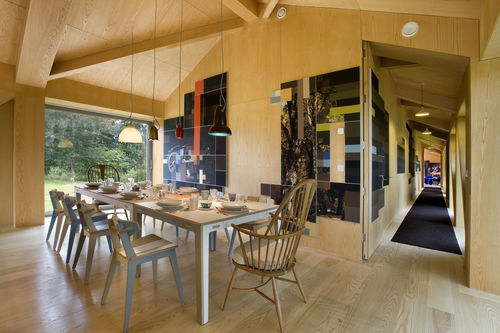
MVRDV with Mole Architects, Balancing Barn, Suffolk. Photo © Jack Hobhouse.

MVRDV with Mole Architects, Balancing Barn, Suffolk. Photo © Jack Hobhouse.
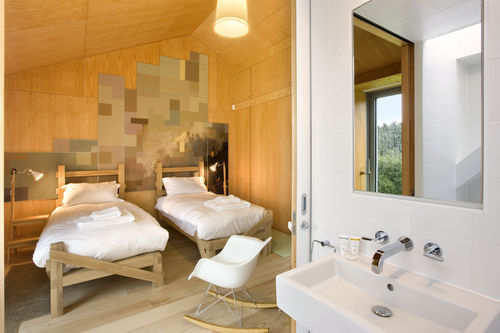
MVRDV with Mole Architects, Balancing Barn, Suffolk.Photo © Jack Hobhouse.
A swing suspends from the bottom of this home, designed by Dutch firm MVRDV, half of which floats in in the air. The structure sits on the crest of a hill, in a bright-green meadow that once belonged to a farm owned by the Suffolk Wildlife Trust. In committing to the project, the architects aimed to honor the plot’s history and its indigenous flora, while also adding their renowned playful spin.
The house’s balancing act—half suspended in air and half rooted in thick, swaying grass—emphasizes the rolling Suffolk landscape and allowed MVRDV to add some of the structure’s most charming details. The floating living room boasts panoramic windows and a glass floor, reminding inhabitants of their intimate position in nature. The swing hangs below, looking out over a glistening pond and a thick tumble of trees. The exterior of the home points to the site’s history as a farm; MVRDV encased it in reflective steel tiles recalling local metal-clad barns, which mirror the surrounding greenery. “One of the briefs was that this is a house for nature and in nature,” de Botton wrote of the project. Indeed, at certain angles, the dwelling looks green rather than silver, melting into the countryside.
Long House
Architect: Sir Michael and Lady Patty Hopkins
Sleeps: 10
Location: Norfolk
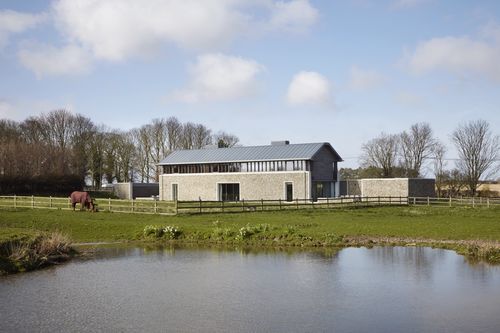
Hopkins Architects, Long House, 2013, Norfolk. Photo © Jack Hobhouse.
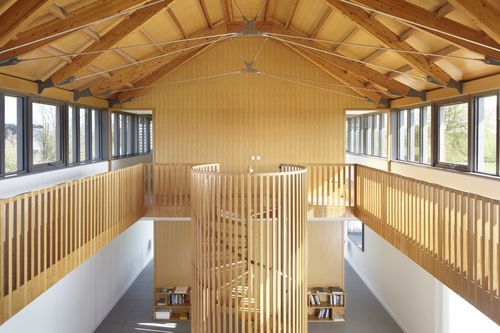
Hopkins Architects, Long House, 2013, Norfolk. Photo © Jack Hobhouse.
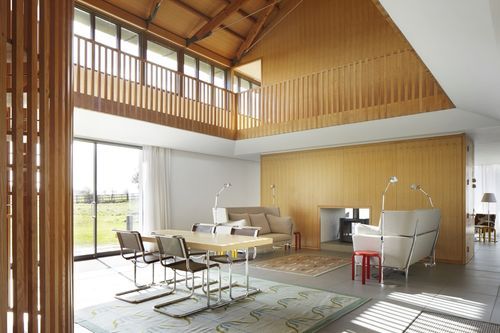
Hopkins Architects, Long House, 2013, Norfolk. Photo © Jack Hobhouse.

Hopkins Architects, Long House, 2013, Norfolk. Photo © Jack Hobhouse.
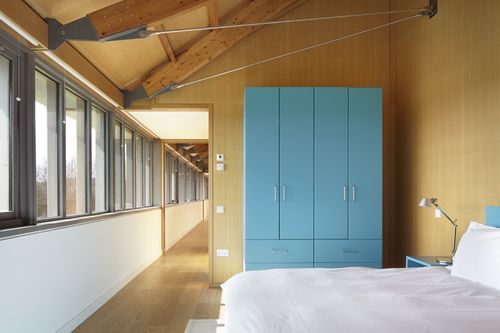
Hopkins Architects, Long House, 2013, Norfolk. Photo © JackHobhouse.
A medieval manor, complete with a moat, once sat on the site of Long House, designed by Sir Michael and Lady Patty Hopkins. This long-gone estate, and the history of building in East Anglia, fed the architects’ plans for the contemporary home they’d erect here. Ancient barns, churches, and walled manors of the region inspired Long House’s most defining feature: an exterior wall built from a mosaic of tawny, ecru, and silvery-grey stones, sourced from a local quarry. Above it, a frieze of windows hints at the luminous, high-ceilinged rooms within. A sprawling central common area comes complete with a library, a fireplace, and a timber spiral staircase resembling a giant, intricate bird cage. Large glass sliding doors flank these details and give way to the surrounding salt marshes and farmland, with its occasional grazing horses. The Hopkins team dotted the mostly grey and umber interior framework with delicious pops of candy color: turquoise dining room chairs and freestanding closets, bright-red stools, and rugs patterned with purple teardrops.
A House for Essex
Architect: FAT Architecture’s Charles Holland and Grayson Perry
Sleeps: 4
Location: Essex

FAT Architecture and Grayson Perry, A House for Essex, 2015, Wrabness. Photo © Jack Hobhouse.
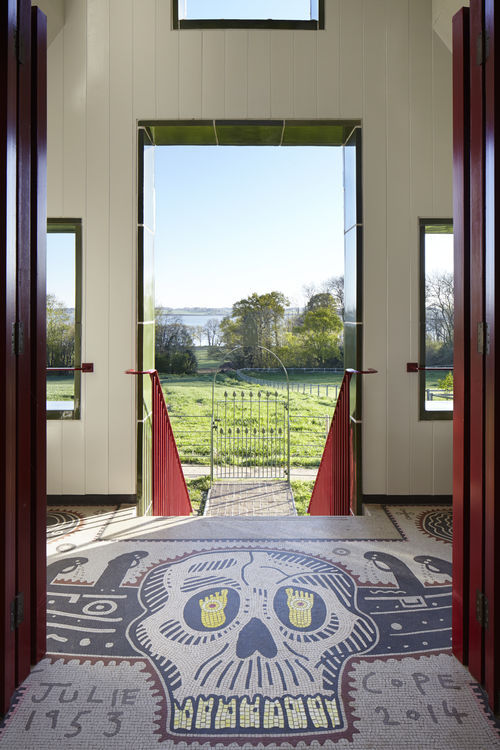
FAT Architecture and Grayson Perry, A House for Essex, 2015, Wrabness. Photo © Jack Hobhouse.
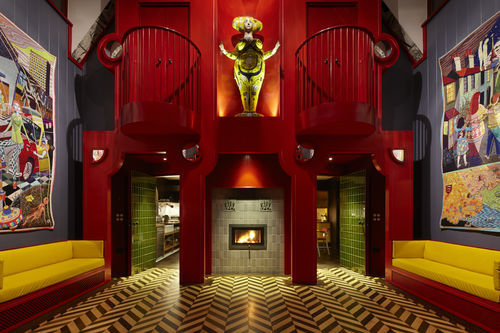
FAT Architecture and Grayson Perry, A House for Essex, 2015, Wrabness. Photo © Jack Hobhouse.
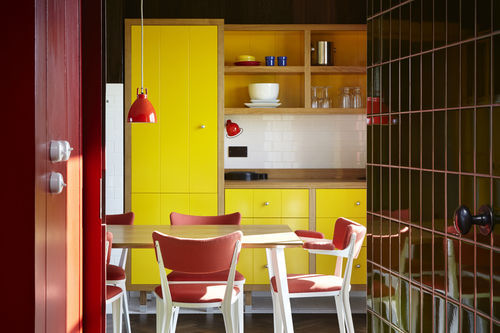
FAT Architecture and Grayson Perry, A House for Essex, 2015, Wrabness. Photo © Jack Hobhouse.
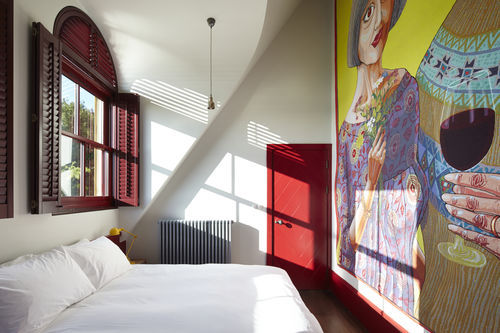
FAT Architecture and Grayson Perry, A House for Essex, 2015, Wrabness. Photo © Jack Hobhouse.
Turner-prize winning artist Grayson Perry teamed up with FAT’s Charles Holland to concoct Living Architecture’s most flamboyant retreat. Part–trippy playhouse and part–Baroque shrine, Perry has referred to the confection as “the Taj Mahal on the river Stour.” The comparison is apt for several reasons. Like the Taj, A House for Essex stands gloriously out of the surrounding landscape. It’s also an extravagant mausoleum—albeit to a fictional character.
Perry and Holland, who both originally hail from Essex, worked from an unusual prompt. They envisioned a home dedicated to the memory of an imagined “Essex Everywoman,” Julie Cope, whose story they used to reflect the character and landscape of their homeland. “It is like a richly encrusted and highly decorated barn, with a healthy dose of Essex bling thrown in,” explained Holland. “Ultimately, it is a built story with something of the qualities of a fairy tale.”
There is a devotional quality to the building: Holland and Perry looked to age-old pilgrimage chapels as they planned its exterior framework. Tall roofs and a long façade are encrusted with ornamentation—including sculptures and tiles depicting Cope’s likeness—honoring the architects’ secular patron saint. Inside, a colorful cacophony of sculptures, paintings, floor mosaics, and furniture tells the story of one woman’s long, colorful life in Essex. Charming, eccentric details reflect Cope’s imagined proclivities, while offering vacationers an architectural playground. Upstairs, two bedrooms come with secret walk-through cupboards that lead to balconies perched above the home’s lofty, kaleidoscopic chapel.
Shingle House
Architect: NORD
Sleeps: 8
Location: Kent

NORD, Shingle House, Dungeness, Kent. © Living Architecture.
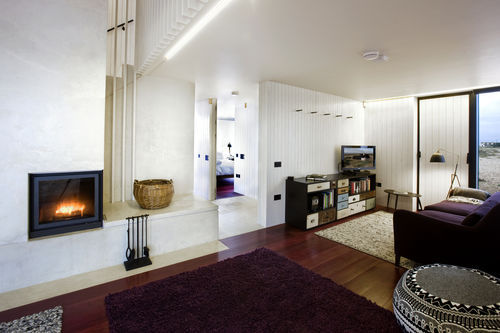
NORD, Shingle House, Dungeness, Kent. © Living Architecture.
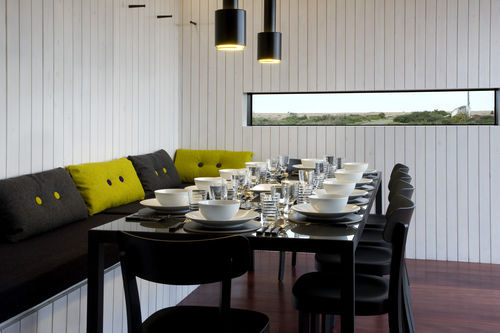
NORD, Shingle House, Dungeness, Kent. © Living Architecture.
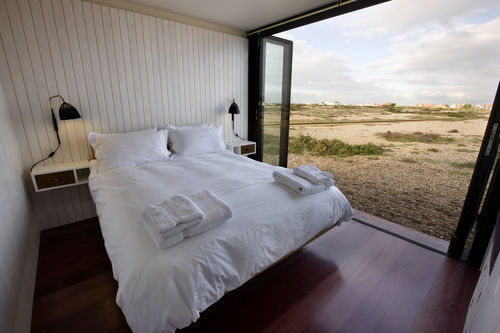
NORD, Shingle House, Dungeness, Kent. © Living Architecture.
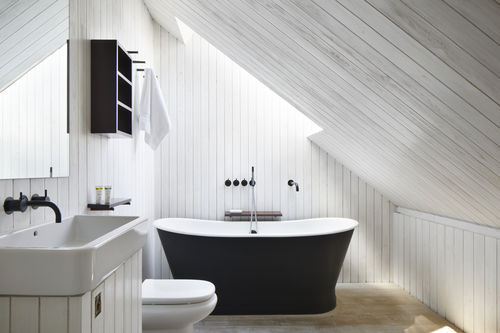
NORD, Shingle House, Dungeness, Kent. Photo © JackHobhouse.
In summer, violet blue flowers, called Viper’s Bugloss, carpet the area around Shingle House, situated on Kent’s Dungeness beach. The Scottish architecture firm NORD drew inspiration from their blooms, making the floors from plum-brown Purpleheart timber. In this and many other ways, the structure responds to the surrounding landscape, which is marked by the ocean, traditional cottages, lighthouses, and the track of a miniature coastal stream train.
NORD looked to train carriages and local fishermen’s huts when designing the home’s slatted façade and cozy, compact interior. Bedroom and dining room windows double as folding doors that open straight onto the pebbly beach, while a bathroom skylight sends a flood of sun over a deep tub. But a bath house adjacent to the main building might be Shingle House’s single greatest perk: Here, visitors can lower themselves into a black, polished-concrete sunken tub with a view of the ocean vista.
Life House
Architect: John Pawson
Sleeps: 6
Location: Wales

John Pawson, Life House, 2016, Wales. Photo © Jack Hobhouse.
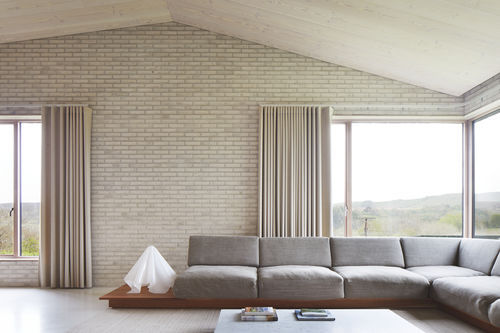
John Pawson, Life House, 2016, Wales. Photo © Jack Hobhouse.

John Pawson, Life House, 2016, Wales. Photo © Jack Hobhouse.
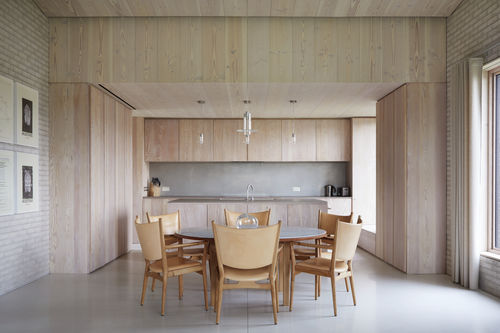
John Pawson, Life House, 2016, Wales. Photo © Jack Hobhouse.

John Pawson, Life House, 2016,Wales. Photo © Jack Hobhouse.
Japanese design and the architecture of Benedictine monks informed this Welsh retreat, devised to optimize relaxation and contemplation. Motivated by a frenetic, anxiety-riddled contemporary world, de Botton and architect John Pawson envisioned a space conducive to quiet, which they hoped would minimize the risk that “we will forget to make time for ourselves, and omit to understand our own minds,” as de Botton has explained.
Every inch of Life House was conceived with tranquility in mind. The structure is situated on a remote, rolling plot in the Welsh countryside. Its minimalist façade of smooth black bricks fluidly gives way to large, paneless windows and barely visible doors. The palette here is limited, ascribing to a yin-yang concept of balance. In contrast to a dark exterior, white and cream materials cover the interior. Couches, tables, and beds generally lie low, chosen for their smooth, uncluttered lines and soft palettes. Even the books and music that fill the structure have been chosen for their therapeutic and transcendent powers, while artist Hamish Fulton curated paths around the house specifically for walks aimed at soothing the mind.
Dune House
Architect: Jarmund/Vigsnæs
Sleeps: 9
Location: Suffolk
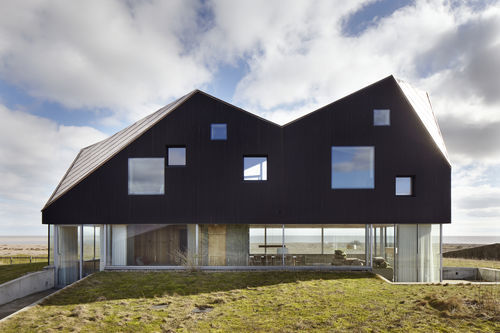
Jarmund/Vigsnæs Architects, Dune House, Thorpeness, Suffolk. Photo © Jack Hobhouse.

Jarmund/Vigsnæs Architects, Dune House, Thorpeness, Suffolk. Photo © Jack Hobhouse.

Jarmund/Vigsnæs Architects, Dune House, Thorpeness, Suffolk. Photo © Jack Hobhouse.
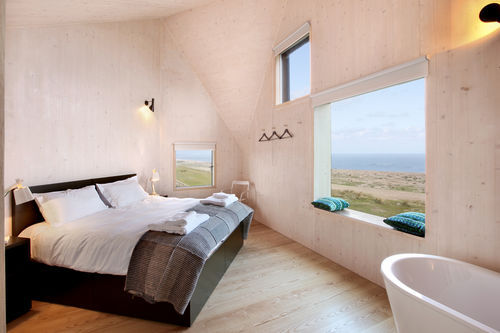
Jarmund/Vigsnæs Architects, Dune House, Thorpeness, Suffolk. Photo © Living Architecture.

Jarmund/Vigsnæs Architects, Dune House, Thorpeness, Suffolk. Photo © Living Architecture.
The faceted, pitched second floor of Dune House indeed resembles the sand mounds that gave the building its name, along with other nautical elements like horseshoe crabs and ship hulls. Those aren’t the only design elements inspired by the North Sea and its surrounding landscape, however. An orange-tinted, steel-alloy roof reflects the mercurial movements of sea and sky, while a wall of first-floor windows gives the impression that there is no barrier between house and sand. Inside, an upper-floor library connects to a terrace, where an afternoon of reading can be accented with occasional ocean-gazing. And of course, there are the tubs: one in every bedroom, where you make like a sea creature by submerging yourself in water while simultaneously watching the roiling waves below.
from Artsy News
0 notes
Text
Give your British mini-break some real style and book a stay in one of these 14 grand houses
Whether, like Plumber Manor in Dorset, they’ve been owned by the same family for hundreds of years or are a cherished new project such as Caer Beris in Wales, manor hotels have a family at their hearts.
Packed with history, these hotels pride themselves on delightfully old-fashioned hospitality with generous meals, antique furniture, gardens to wander in and countryside to admire.
There are famous ones, including Le Manoir aux Quat’Saisons, and Gravetye and Cowley Manors, but there are plenty of others to discover, and some of them have superb deals this year.
Lympstone Manor, Devon
Lympstone Manor in Devon has a Michelin-starred restaurant and 21 bedrooms in the main house, with high levels of indulgence that include a resident artist and a vista of the River Exe
Stunning: Pictured is one of the bathrooms, which features two freestanding gold baths and a marble double sink
When chef Michael Caines bought this Regency mansion near Exmouth in 2017, part of the appeal was the surrounding farmland which he thought would make an ideal terroir for English sparkling wine. More than 17,000 vines were planted, and the first vintage is due in 2021.
In the meantime, there’s a Michelin-starred restaurant and 21 bedrooms in the main house, with high levels of indulgence that include a resident artist and a vista of the River Exe. New this year are equally luxurious shepherd’s huts that sleep up to five guests. Doubles from £560, including breakfast and lunch (lympstonemanor.co.uk).
Ockenden Manor, West Sussex
Sussex treat: Ockenden Manor, near Cuckfield, serves afternoon cream tea with scones and finger sandwiches
Tucked into the countryside near the South Downs, next to the boutique-filled village of Cuckfield, parts of this mansion date from the 16th Century. If you want to delve into the oldest part of the hotel, ask for the Master Timothy suite, which has wooden panelling, reading nooks and an adjacent room for children. Downstairs is given over to a bar, drawing rooms and a restaurant which overlooks a semi-wild garden; its wine list reflects the burgeoning Sussex vineyard scene.
The former walled garden now houses a spa with an indoor and outdoor swimming pool; there are also a handful of suites, allowing guests to drift between their rooms and treatments.
One-night Spa Break Getaway costs from £143pp for dinner, B&B with £25 voucher towards a spa treatment from Monday to Friday (prideofbritainhotels.com).
Buckland Manor, Worcestershire
Chef Will Guthrie raids the nearby Vale of Evesham for produce both in the restaurant and for hampers to take on picnics around Buckland Manor and beyond
There are 15 rooms, some of them with four-poster beds and views of church spires. Distinctly more family-friendly than many Cotswolds hotels, there are interconnecting rooms as well as special menus for children
Domesday mention: The manor house has ‘Domesday Book history and plenty of modern-day appeal’
A manor house with Domesday Book history and plenty of modern-day appeal. The 15th Century timbered hall provides the backdrop for afternoon tea in winter, although in summer it spreads out into the gardens.
The beautiful village of Broadway is a gentle hike away, so are the gardens at Snowshill. There are 15 rooms, some of them with four-poster beds and views of church spires. Distinctly more family-friendly than many Cotswolds hotels, there are interconnecting rooms as well as special menus for children.
Chef Will Guthrie raids the nearby Vale of Evesham for produce both in the restaurant and for hampers to take on picnics around the hotel and beyond.
Two-night stays from £315pp, including B&B plus one dinner and a National Trust card worth £127 (bucklandmanor.co.uk).
Plumber Manor, Dorset
Generations of the Prideaux-Brune family have lived at Plumber Manor in Dorset since they built it in the 1600s – and it shows
A textbook West Country manor house, from the long driveway surrounded by fields to the mullion windows framed by roses.
Generations of the Prideaux-Brune family have lived at Plumber since they built it in the 1600s and it shows, with resident black labradors, proper family portraits and a collection of classic cars.
There are six bedrooms in the main house, ten others in a restored stone barn. Spread over three dining rooms, the menu is classic country house, strong on cheese souffle and peppered beef, followed by home-made puddings.
B&B from £155. For a three-night minimum stay, dinner, B&B is from £137.50pp per night (plumbermanor.co.uk).
Manor House, Wiltshire
The 14th Century ivy-clad manor house in Wiltshire is filled with stained-glass windows, beams and a Michelin-starred restaurant
There are 21 rooms in the main house and 29 cottages around the grounds, some of which are dog-friendly
With its charming honey-stoned houses, Castle Combe is often described as England’s most beautiful village, and it has caught the eye of many a Hollywood director. It has a 14th Century ivy-clad manor house – in the same honey-coloured stone to match – filled with stained-glass windows, beams and a Michelin-starred restaurant. There are 21 rooms, including the delightful Lordsmeer suite in the main house and 29 cottages around the grounds, some of which are dog-friendly. There’s an 18-hole golf course and a glorious Italianate garden, and the Bybrook river meanders through the grounds. B&B doubles from £250 (exclusive.co.uk/the-manor-house).
Titchwell Manor, Norfolk
A hotel that catches the posh but gently boho North Norfolk vibe beautifully; this Victorian building is too close to the beach to have any airs and graces, but there’s a lot of breezy charm. Meals are served in an expansive conservatory and there are 26 rooms, some with hot tubs.
Owned by the Snaith family, it is managed by their son Eric, who also runs Norfolk’s smartest fish and chip shop in nearby Thornham. Family-friendly, it’s also a stylish bolthole for birdwatchers; there’s an RSPB reserve next door.
B&B from £140. A two-night walking break including dinner, B&B plus a packed lunch on one day costs from £265pp (titchwellmanor.com).
Longueville Manor, Jersey
Longueville Manor, Jersey, puts food and wine at the centre of its appeal
This Relais & Châteaux hotel may put food and wine at the centre of its appeal, but there’s much more on offer.
The 30 rooms and suites are cream and serene, generously sized and with French-accented luxury.
For extra privacy, there’s a two-bedroom cottage in the grounds, alongside tennis courts and a spa. The hotel also has its own yacht.
Longueville became a hotel in 1949 and is now in the third generation of family ownership.
There’s a fine cellar, with more than 5,000 bottles, a forager on staff to supplement the extensive kitchen garden and honey from hives dotted around the grounds.
Doubles from £225, room-only (longuevillemanor.com).
Aynsome Manor Hotel, Cumbria
Aynsome Manor Hotel, Cumbria, has 13 bedrooms, some in the beamed eaves of the building, all with the sort of views that will have you pulling on your walking boots
For those who like the wilder side of Cumbria, here is a handsome, good-value manor near Cartmel, now run by the second generation of the Varley family.
There are just 13 bedrooms, some in the beamed eaves of the building, all with the sort of views that will have you pulling on your walking boots. Guests eat in the dining room rather than a restaurant and the food aims to make the flavours sing with minimal fuss. The menus are set-price and a bargain at three courses for £30. B&B from £90 per night (aynsomemanorhotel.co.uk).
Caer Beris Manor, Powys
The Southwick family bought Caer Beris Manor in Powys last year and spent lockdown continuing their renovation programme
Lord Swansea built this mock-Tudor mansion, surrounded on three sides by the River Irfon, in 1896 on the foundations of a 13th Century castle. It was bought by the Southwick family last year.
There are 22 rooms spread across the estate, ranging from suites to single rooms. The family spent lockdown continuing their renovation programme and have created picnic areas throughout the grounds, which also hold orchards and an otter hide, while there’s trout, salmon and grayling to fish for. The 1898 restaurant sources its ingredients locally. Mains start at £16. B&B from £90 (caerberis.com).
Manor House, Argyll and Bute
Manor House, Argyll and Bute, is ‘delightfully gentle’ with just 11 rooms and spectacular West Coast views
The Scots don’t do manors in quite the same way as the English – fortified castles were more their thing. This hotel is one of the exceptions, and it’s delightfully gentle with just 11 rooms and spectacular West Coast views. It was built for the Duke of Argyll in 1780, next to Oban’s harbour. Staying here is a superb introduction to the Inner Hebrides, from the freshly caught seafood in the restaurant to sunset views from McCaig’s Tower behind the hotel – although watching from the Nelson bar at the hotel with a fine whisky in hand is nearly as good. Sailors can use the hotel’s own mooring. Double B&B from £224 (manorhouseoban.com).
The Manor at Sway, Hampshire
Pictured is one of the bedrooms at The Manor at Sway, Hampshire, where ‘William Morris mixes with a touch of modern design’
All the space and grace that the Edwardians could muster comes into play at this hotel on the southern edge of the New Forest, where William Morris mixes with a touch of modern design. It’s a great car-free option as it’s near the railway station and there are wonderful walks into the forest and heath to explore from the hotel. There are just 11 bedrooms and a restaurant serving local produce. Dishes include local pork with black pudding, crisp ham and charred baby gem lettuce, while puddings include lemon curd tart with basil. Doubles from £189, including dinner, breakfast and afternoon tea (themanoratsway.com).
Moonfleet Manor, Dorset
Room with a view: Moonfleet Manor, a Georgian mansion in Dorset, overlooks the magnificent Chesil Beach
Not just for adults: One of the lounges at the hotel, which is child-focused, with play areas and picnics
If you want to get your child manored up, head here. Overlooking Chesil Beach and part of the Luxury Family Hotel group, it’s thoroughly child-focused. There are interconnecting rooms, indoor and outdoor play areas, including a pool, and in a Covid-made-fun way, picnics are available for every meal including breakfast. The South West Coastal Path runs alongside the back garden.
In the Georgian mansion, there’s a playfulness that adults will appreciate too, with high teas and grown-up meals and, above all, Snoopy, the venerable hotel spaniel.
Two nights from £329, including breakfast and dinner for two. Children stay free but are charged for meals; two hours of childcare a day is included from September 7 when the creche reopens (moonfleetmanorhotel.co.uk).
Long Crendon Manor, Buckinghamshire
Long Crendon Manor in Buckinghamshire has bedrooms with original features, a bakery, farm shop and florist
Not a hotel as such, but you can stay in this manor, which is stacked with beamed charm. Parts of the main house date from the 12th Century. It’s still a working estate, with ducks and geese in the orchard that creates the cider, and Gloucester Old Spot pigs that provide the morning bacon.
Head into the courtyard and there’s a bakery, farm shop and florist. The farm shop cafe serves lunch and it’s walking distance from two pubs in the village. B&B doubles from £145 (longcrendonmanor.co.uk).
Rothay Manor, Cumbria
This small foodie hotel in the heart of the Lake District is owned by Jamie and Jenna Shail, who have bought significant flair and rolltop baths to the low-slung white house near Ambleside. Eight of the rooms on the ground floor are dog-friendly; first-floor rooms have balconies. Its main restaurant has three AA rosettes and five courses start from £70 a head, but there’s also a more casual restaurant. B&B from £221 (rothaymanor.co.uk).
The post Give your British mini-break some real style and book a stay in one of these 14 grand houses appeared first on Shri Times News.
from WordPress https://ift.tt/3ld1rKb via Blogger https://ift.tt/2El4uj1
#Blogger#Give your British mini-break some real style and book a stay in one of these 14 grand house
0 notes
Text
Dezeen's top 10 cabins of 2021
Ever have the urge to get away from it all and retreat to a cosy cabin somewhere quiet and remote? In the second roundup of our review of 2021, we pick out 10 of the best cabins on Dezeen this year, including a metal tube in Russia and a house on stilts in the Brazilian forest.
Photo is by ImagenSubliminal
Tini, Spain, by Delavegacanolasso
This small, prefabricated cabin designed by Spanish studio Delavegacanolasso can be ordered online and delivered on the back of a truck.
It comes either off-the-shelf ready for use as an office or customised, with the option to connect multiple units together to form a house.
Find out more about Tini ›
Photo is by Marc Goodwin, Archmospheres
Niliaitta, Finland, by Studio Puisto
Elevated on a single column to minimise the size of its footprint, this striking, black-painted cabin is hidden within woodland near the Salamajärvi National Park in Finland.
Its designer, Studio Puisto, based the structure on the raised wooden huts used by indigenous Samí people to safely store food outdoors known as Niliaitta – though this version features most of the amenities of a modern hotel room.
Find out more about Niliaitta ›
Photo is by Rupert McKelvie
Holly Water Cabin, England, by Out of the Valley
Holly Water Cabin is a holiday home on a farm in Devon dreamed up by architecture studio Out of the Valley.
Constructed from multiple types of timber with a pitched roof and sliding doors opening onto a sheltered veranda, the cabin is intended to immerse guests in nature.
Find out more about Holly Water Cabin ›
Photo is by Cristobal Palma
La Tagua and La Loica, Chile, by Croxatto and Opazo Architects
Like two lookout posts, La Tagua and La Loica are set 80 metres above the Pacific Ocean on a steep hillside in Navidad.
In an attempt to make the cabins blend in with their coastal surroundings, Croxatto and Opazo Architects clad them in reclaimed oak treated with petroleum oils to protect against corrosion from the salty air.
Find out more about La Tagua and La Loica ›
Photo is by Henny van Belkom
Indigo, Netherlands, by Woonpioniers
Amsterdam studio Woonpioniers created this cabin from pre-fabricated laminated timber, with the whole structure's carbon footprint designed to be as small as possible.
The front of the house is dominated by large windows, while inside, the wooden walls curve upwards right to the roof's apex.
Find out more about Indigo ›
Photo is by Ilya Ivanov
Russian Quintessential, Russia, by Sergey Kuznetsov
This remarkable tubular house, balanced on the edge of a slope in Russia's Nikola-Lenivets Art Park, was designed by Moscow's chief architect, Sergey Kuznetsov.
"The idea was to create something with an element of magic," he told Dezeen. Despite being 12 metres long and weighing around twice as much as a fully-grown elephant, the whole thing is held together by just six bolts.
Find out more about Russian Quintessential ›
Photo is by Federico Cairoli
Casa Tejida, Colombia, by Santiago Pradilla
Casa Tejida, which translates as woven house, takes its name from the facade of woven wood screens along the cabin's side filtering light and air.
The house was designed by architect Santiago Pradilla and architecture collective Zuloark as a prototype for more sustainable, local forms of construction.
Find out more about Casa Tejida ›
Photo is by Rasmus Hjortshøj, Coast
The Author's House, Denmark, by Sleth
Built for a writer as a full-time workspace, this copper-clad cabin is nestled in a lakeside forest.
"The area is so lush and beautiful that we wanted to really capture the essence of it, to try to create a seamless transition between the inside and outside," said Søren Leth, a founding partner of Sleth, which designed the house.
Find out more about The Author's House ›
Photo is by Tian Fangfang
The Seeds, China, by ZJJZ Atelier
Wrapped in wooden shingles and mirrored aluminium tiles, The Seeds are a cluster of holiday cabins designed by ZJJZ Atelier for a woodland hotel in China's southeastern Jiangxi province.
Each stilt-raised pod contains a bedroom, bathroom, storage area, attic lounging space and a front terrace.
Find out more about The Seeds ›
Photo is by Rafael Medeiros/Gustavo Uemura
Monkey House, Brazil, by Marko Brajovic
Last but not least, Marko Brajovic's Monkey House was built as an isolated haven during the coronavirus pandemic.
It sits on a forest of slim stilts, a system Brajovic designed after observing how the Juçara palm tree native to the forest uses its roots to anchor its slim stem to the earth.
Find out more about Monkey House ›
The post Dezeen's top 10 cabins of 2021 appeared first on Dezeen.
0 notes
Text
POSTCARDS FROM THE WEEKEND – LUTTRELL’S TOWER
Breakfast with a view. This last weekend, we were lucky to be invited by The Landmark Trust, to stay at their atmospheric property Luttrell’s Tower in Southampton. We packed up a car with two of our favourite people, their 7-month-old and everything we needed for a two day break, then headed along the coast for a couple of days of relaxing and restorative sea air.We arrived at dusk and after getting a little lost eventually found our way to the tower, looming in all its glory out of the winter night sky. Built around 1780, Luttrell’s is a private tower on the shores of the Solent, with smugglers tunnels and breathtaking views of the sea. A magical place where you can sit and watch boats passing for days on end. The dusty blue doors beckoned us in and we explored the rooms on our ascent up the winding tower stairs. The blue room has huge windows and shutters to batton down for privacy and protection from the elements. Simply furnished with antiques and traditional decor this room looks out onto the sea, gardens and woodlands nearby. Up the winding stairs to the next level, the green room has smaller windows for a cosy feel, with more antiques and etchings of historical voyages. Gold accents with rich rugs, wooden floors and more of that coastal light, sleeping and waking in this building is an absolute pleasure. As I said, we arrived at dusk and all piled in with our bags and boxes. We pre-prepared an evening meal for each night so we could spend as much time relaxing as possible. Friday night was spent sitting at the huge bay window facing out into the darkness with the sound of the wind and sea for music. Arriving after dark we didn’t know what to expect when the sun came up. I spent the evening excitedly wondering how close the sea was and what the view would be when we woke up the next day. The living space is bright yellow with huge windows on three sides, a fireplace and comfy chairs for fireside relaxing. I didn’t capture every detail of this room as a whole, if you ever visit (which I highly recommend) it is just so lovely to discover for yourself. I baked two batches of granola to fill a big jar for the weekend and we had breakfast using the beautiful Landmark Trust crockery. I fell in love with the blue and white patterned china now need to find a teapot just like this!The view was everything we hoped and more. I ran up the winding stone stairs to an 8am view of waves rolling in and boats slowly gliding by like huge metal swans on a rippling lake. The sky was pale blue-grey, the breeze gently fluttering the silvery green leaves of the Ilex trees below.We sat here for breakfast and an hour or two later for tea and cake. Then it was time to search the basement for the secret tunnel that leads to the beach for a fresh air walk, a snuggled sleep for this little one below and some seaside treasure hunting.With winding stairs in both directions, we climbed all the way to the top of the tower for a blast of sea air before heading all the way down to the underground tunnels – our direct route to the beach. Dusty green Cyclamen leaves decorated the sleeping winter garden, while daffodil and crocus tips peeked through the soil, waiting for warmer days to pop their petals out. We found shells, seaweed and branches softened by their time in the waves. Bringing them all home to take a closer look and read entries from all the previous guests of the tower, dating right back until 1971. Inside the volumes are beautiful drawings, paintings, poems and detailed descriptions of holidays passed – and some beautiful handwriting! Later, a bit more boat watching, a very soothing pastime indeed. Ferries, fishing boats, yachts and container ships all navigating the water between the two islands. As the light fades, across the water the lights of the Isle of Wight start to twinkle out of the darkness. The best way to enjoy a place like this is to pack everything you need so no time is wasted away from the magic and history of the property. We didn’t leave the grounds for our whole visit – except for our beach meander.My top tip if you stay here is to go down to the Bijou bathroom before dinner, draw yourself a bath, pop a candle in the alcove, shut the door and open the porthole window to listen to the evening wind rushing by. I took some of my favourite Aesop beauty products with me and had a mini spa half hour before getting dressed and heading back up to the dining room for dinner, bliss.The place has a feeling of an Agatha Christie novel about it (in a good way)! Inside there is everything you need for preparing food and truly taking some time out the real world. To sink back into history and really enjoy some calm. For those who can’t quite sit still, there are interesting books, games and puzzles. We loved reading about Luttrell’s Tower throughout history. We were sad to leave the rustling hydrangeas and pack the car for home. I’d love to visit this place in all seasons to see how its surroundings change.These are the top five places on my Landmark Trust visit wish list – 1. Danescombe Mine – Calstock, Cornwall. Nestled in the woods this is the engine house of a former mine. The living room leads onto wooden decking where you can sit out and overhear the stream running past the back door and wonder what life was like here a century ago
2. Hanmers – Lundy, Bristol Channel, Devon. A fisherman’s hut, Hanmers was built by a fisherman in 1902. He chose a good site, a dip in the hill, on the path from the beach to the castle, so the place is sheltered but has the usual wonderful view out to sea towards Devon.
3. La Maison des Amis – Gif-sur-Yvette, Essonne, France. La Maison des Amis is one of the guest cottages created by the Duke and Duchess of Windsor in the grounds of Le Moulin de la Tuilerie. The ground floor opens onto a private terrace overlooking the main gardens; the first floor is open to the original roof timbers and also has views of the gardens and woodland beyond.
4. The Pineapple – Dunmore, Central Scotland. An eccentric 18th-century summer house built in the shape of a pineapple – it presides over a walled garden, while at the back is a private garden for those staying. It is an eccentric work, of undoubted genius, built of the very finest masonry.
5. Cul-na-Shee – Saddell, Kintyre, Argyll and Bute. Cul na Shee means ‘nook of peace’ in Gaelic and this simple weathered boarded cottage is well-named. Set in a stunning location on Saddell Bay on the east coast of Kintyre, it looks out across the Kilbrannan Sound to the Isle of Arran. Here in the 1920s a schoolteacher, the daughter of a local minister, built herself a simple home for her retirement, on the grass behind a rocky beach.
Collaboration Note: Our stay at Luttrell’s Tower was a welcomed gift from The Landmark Trust to highlight one of their amazing properties – all words are my own. Photos by Dean and myself.
0 notes